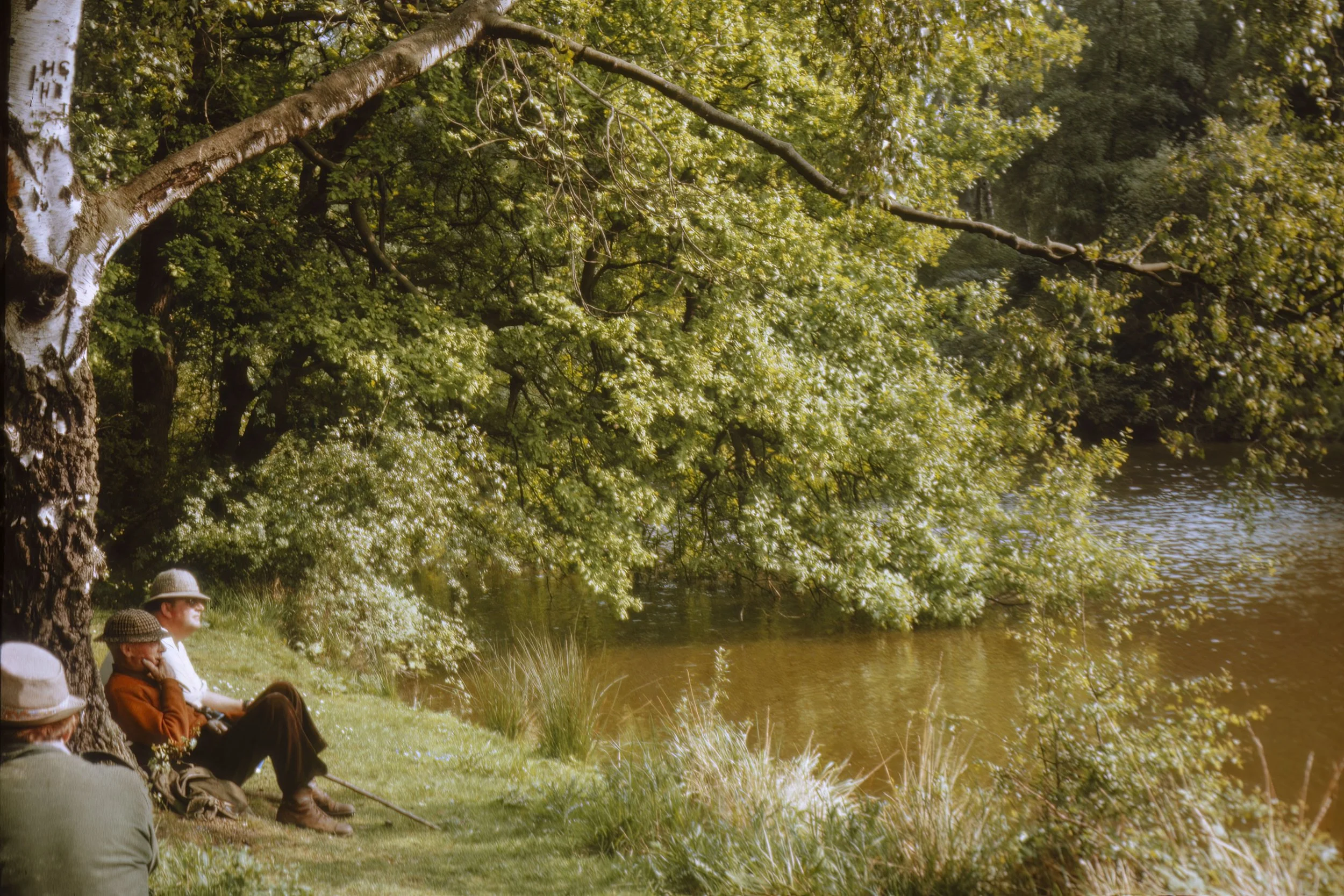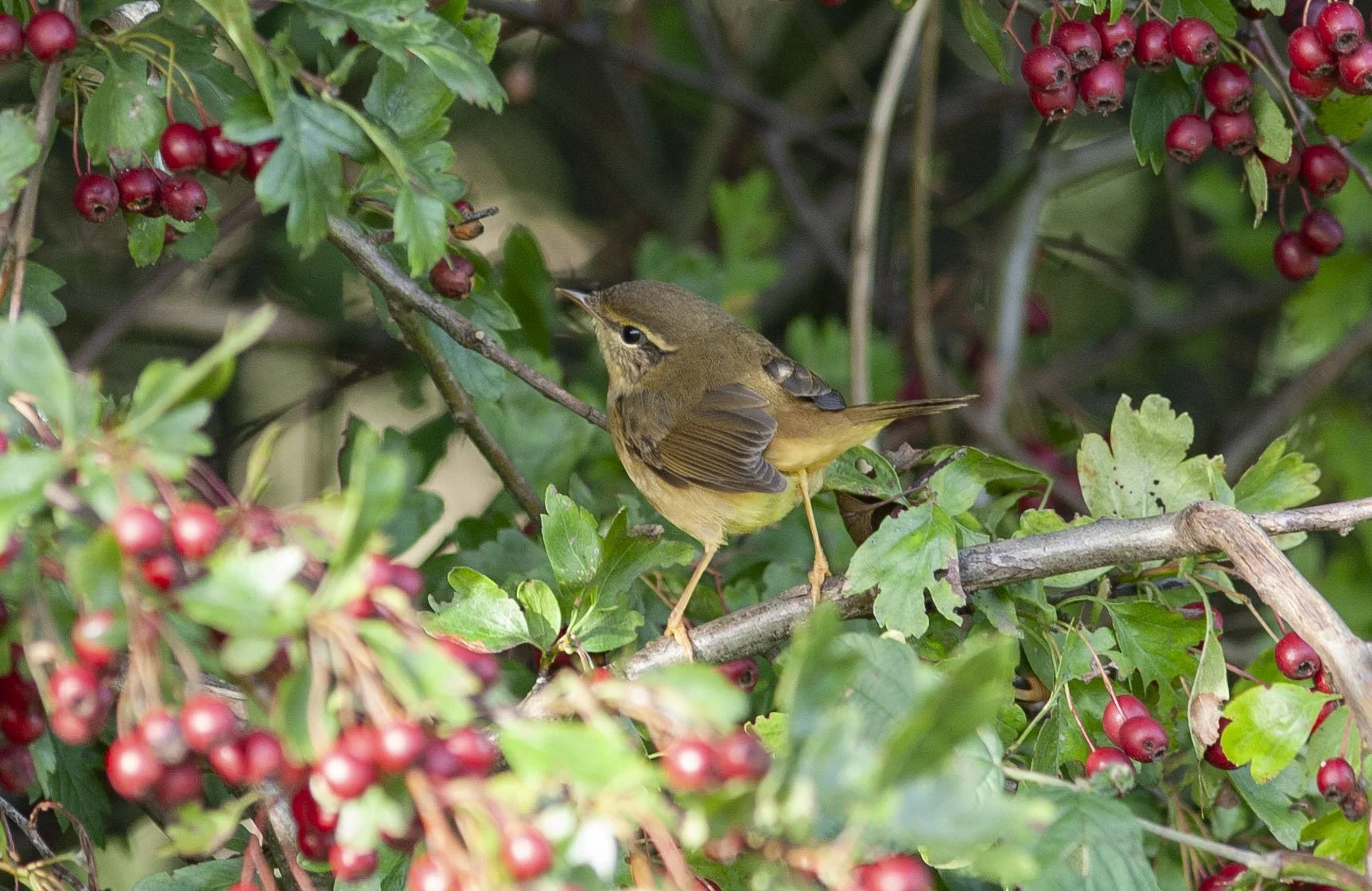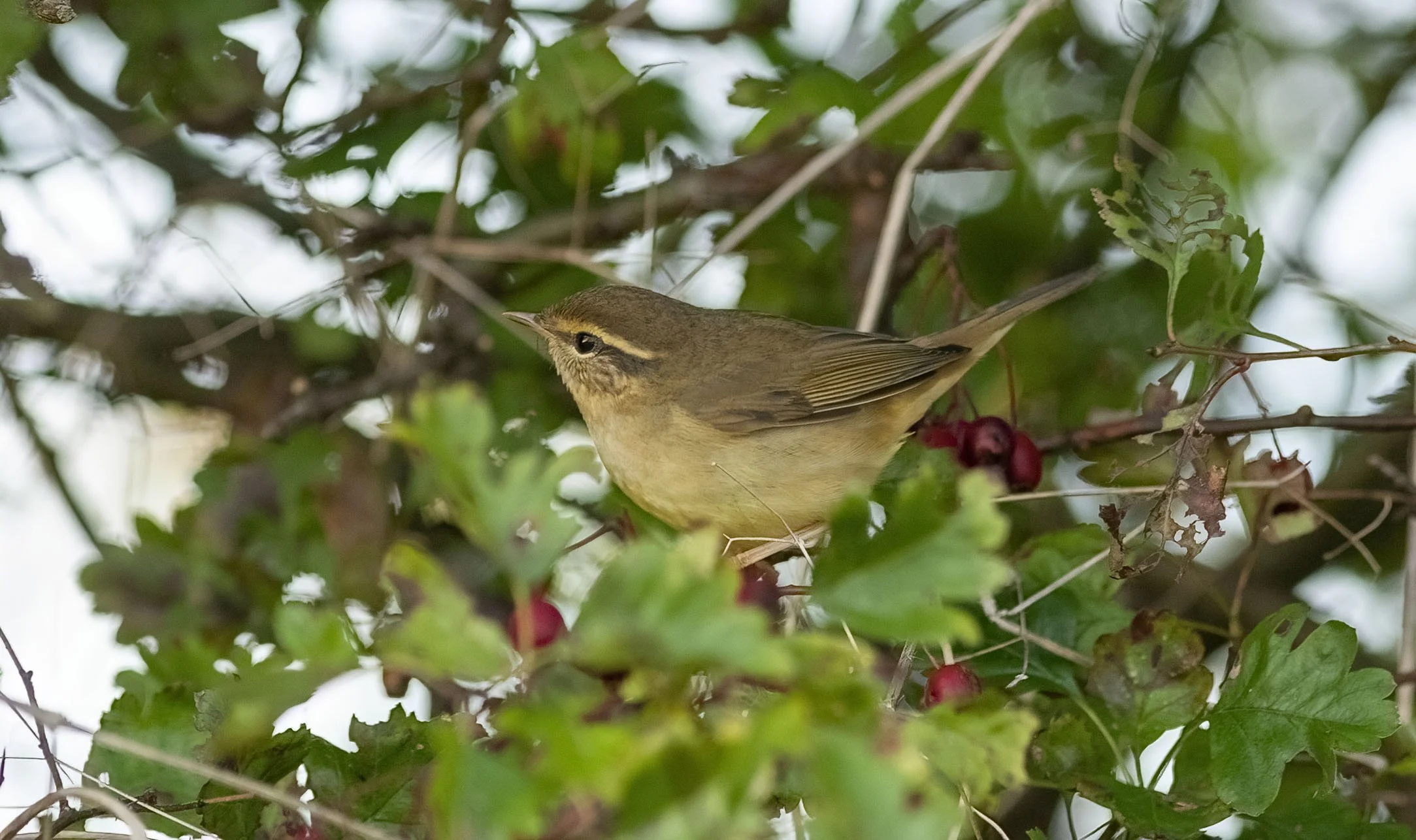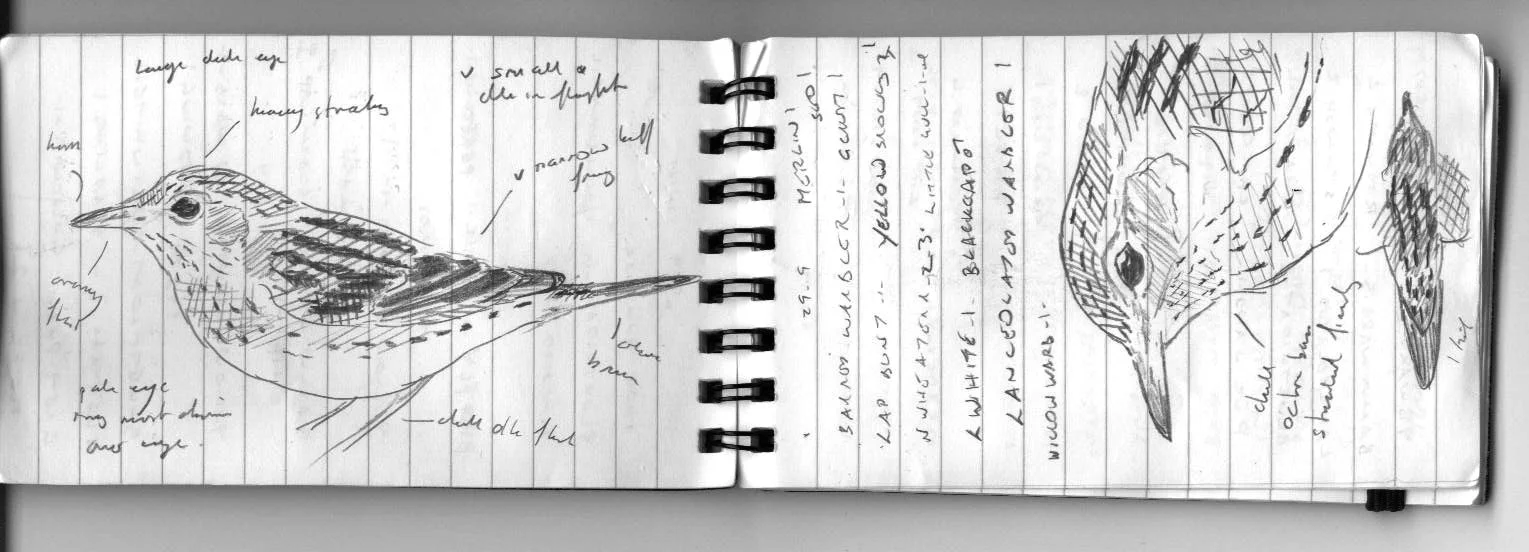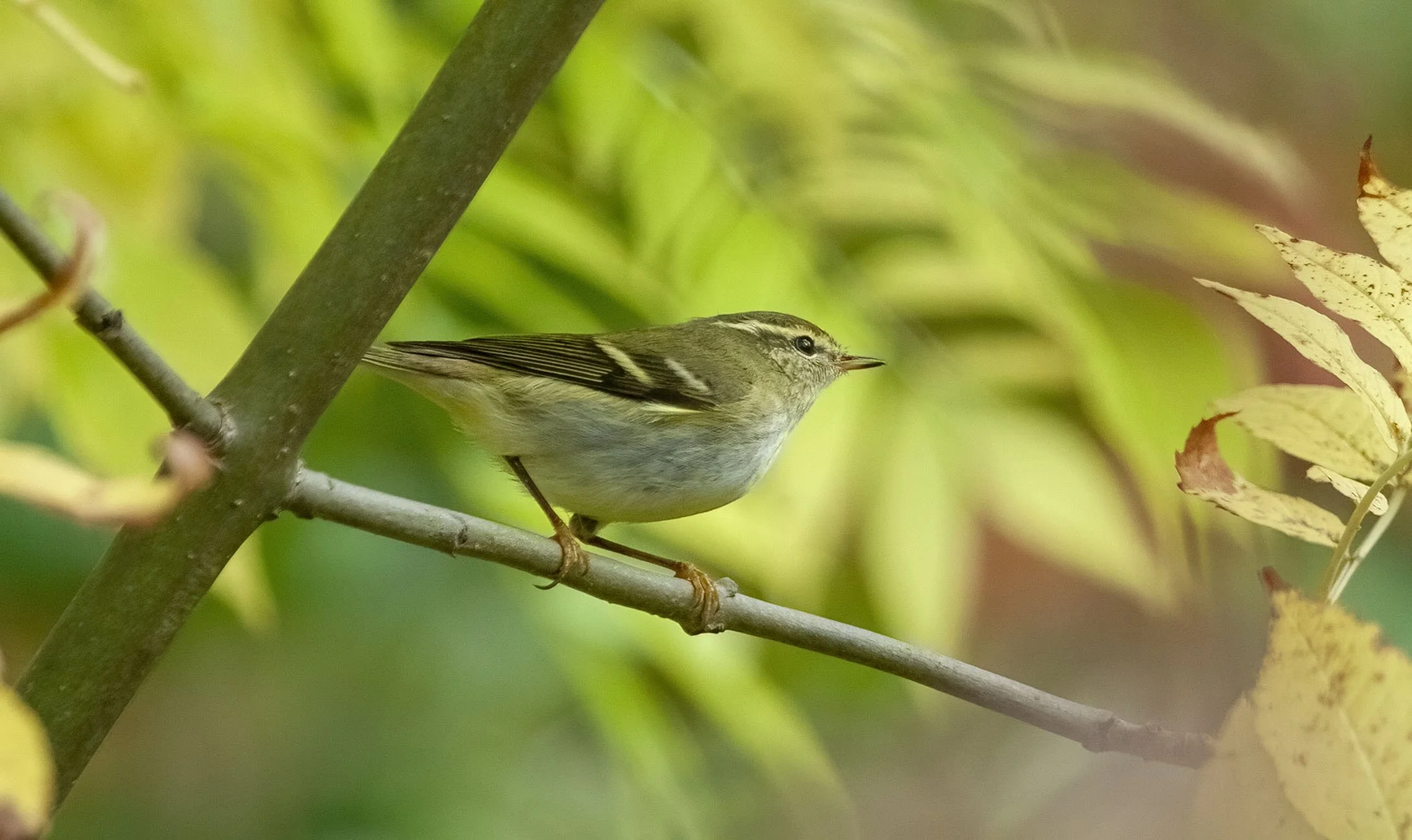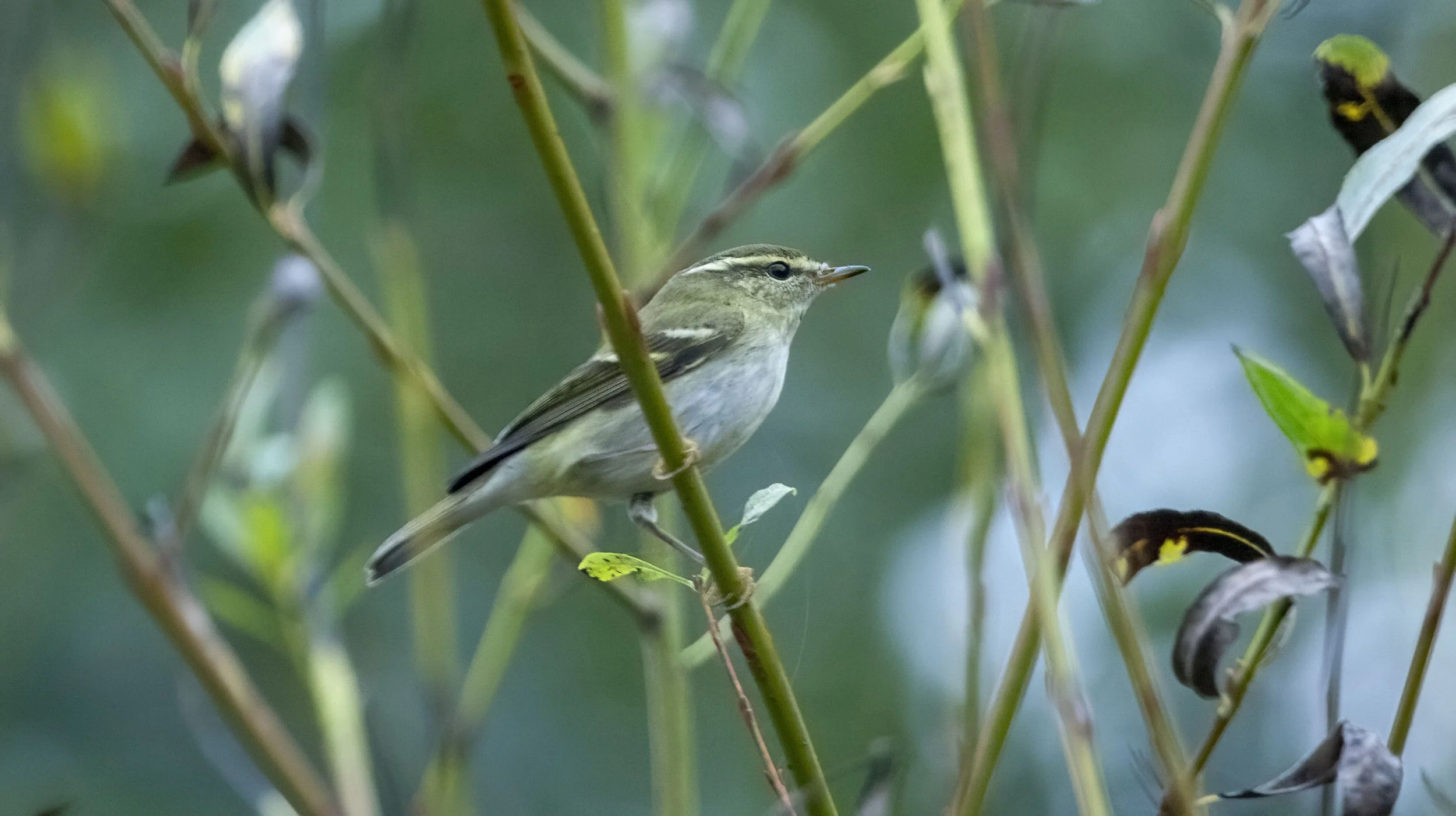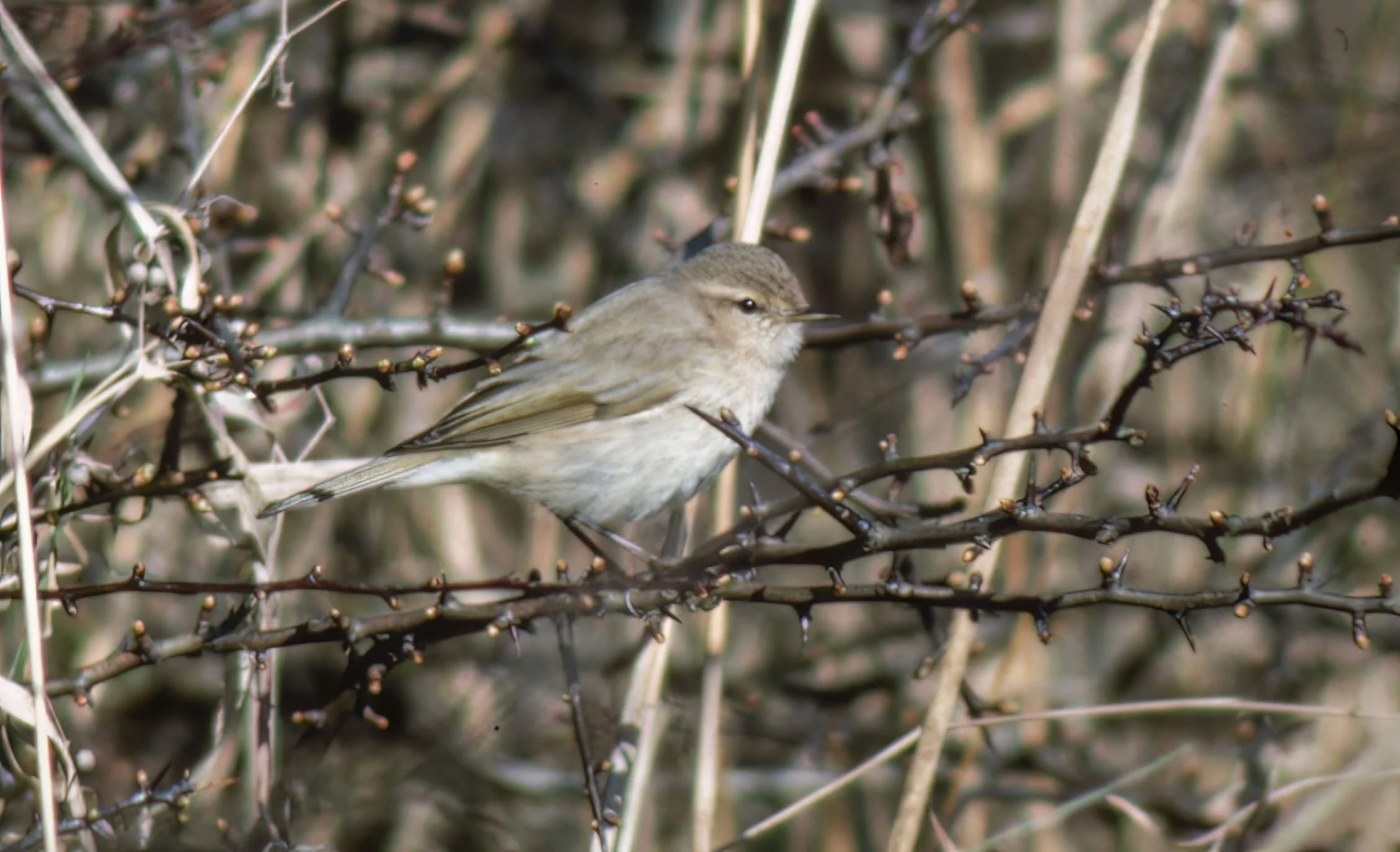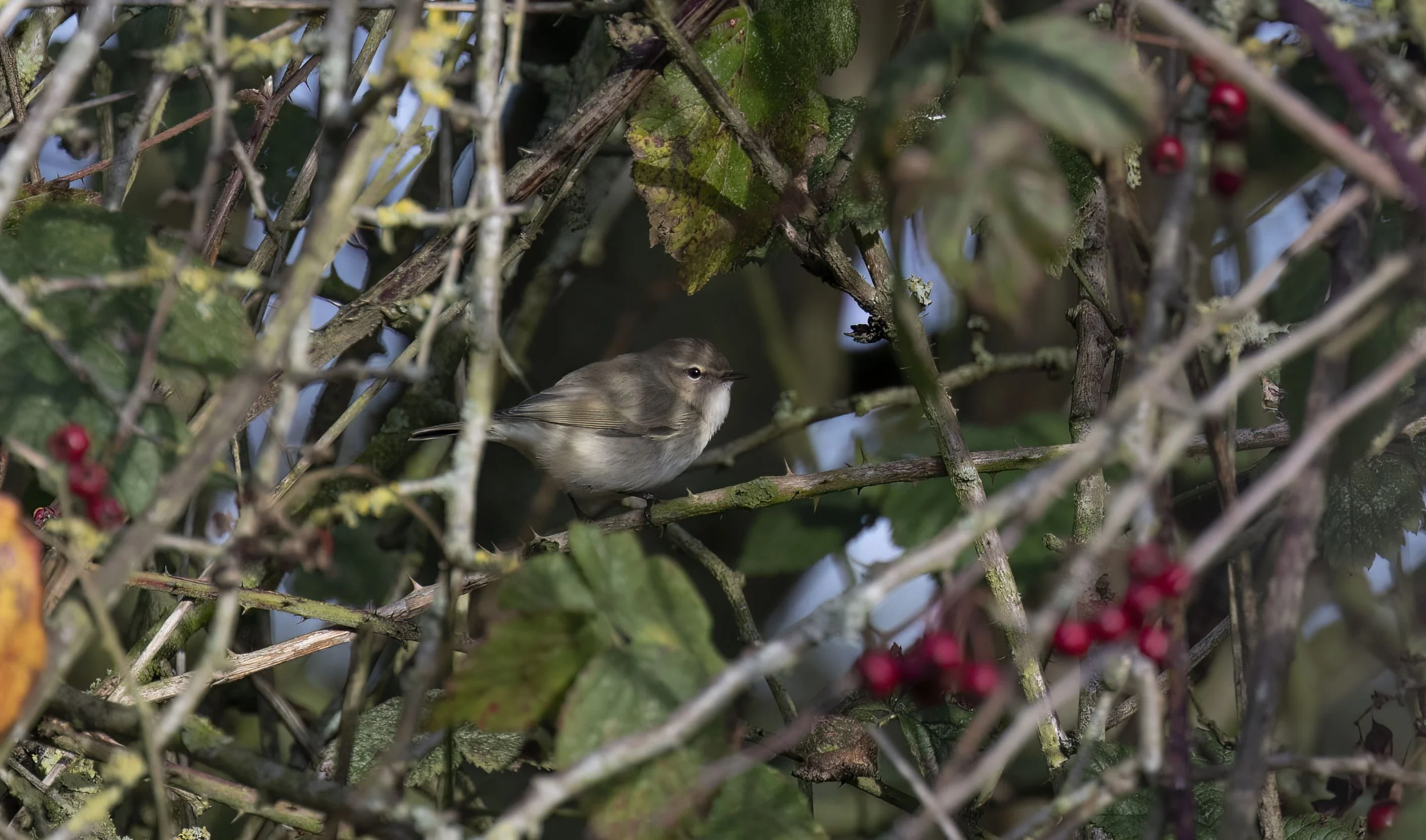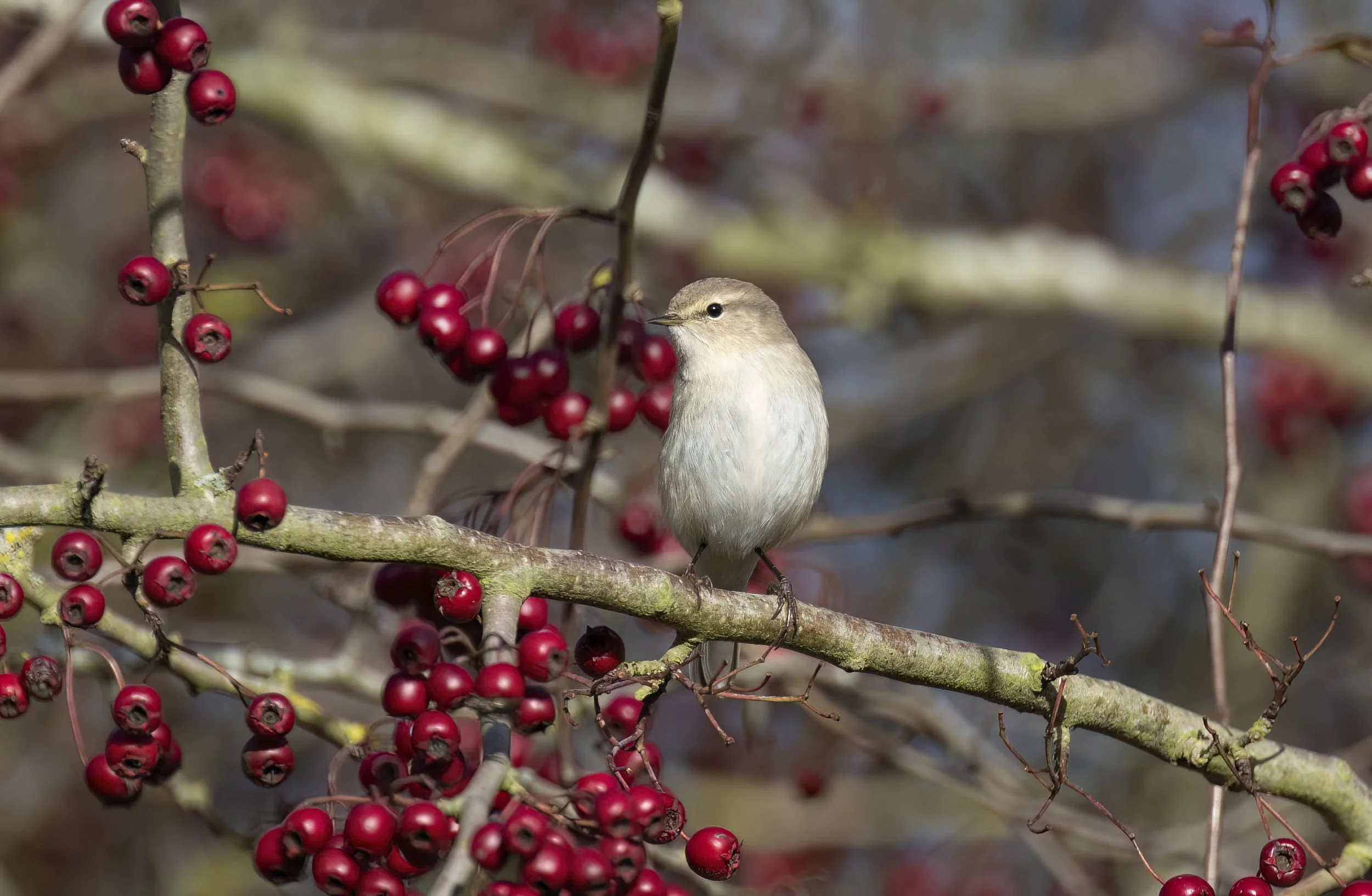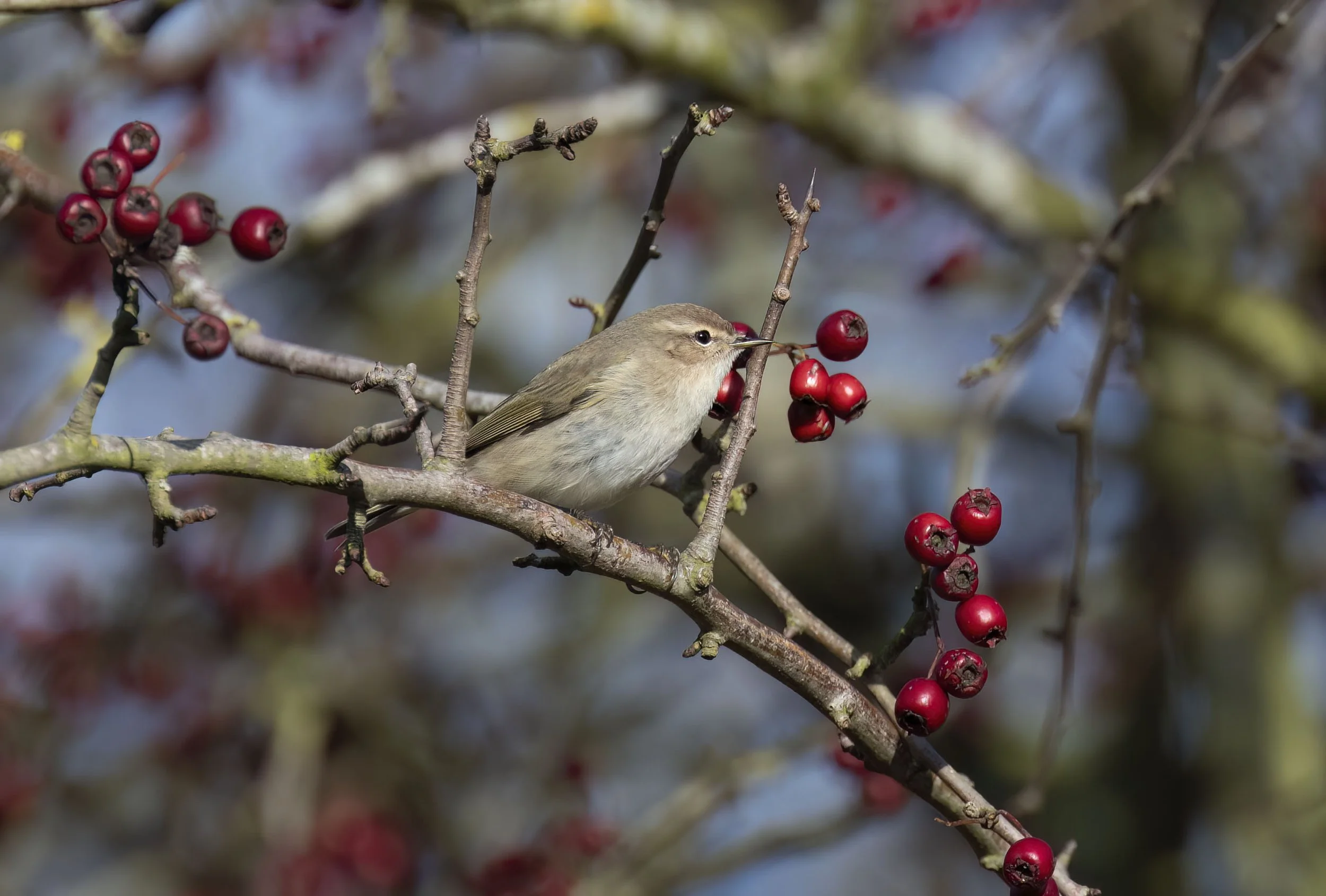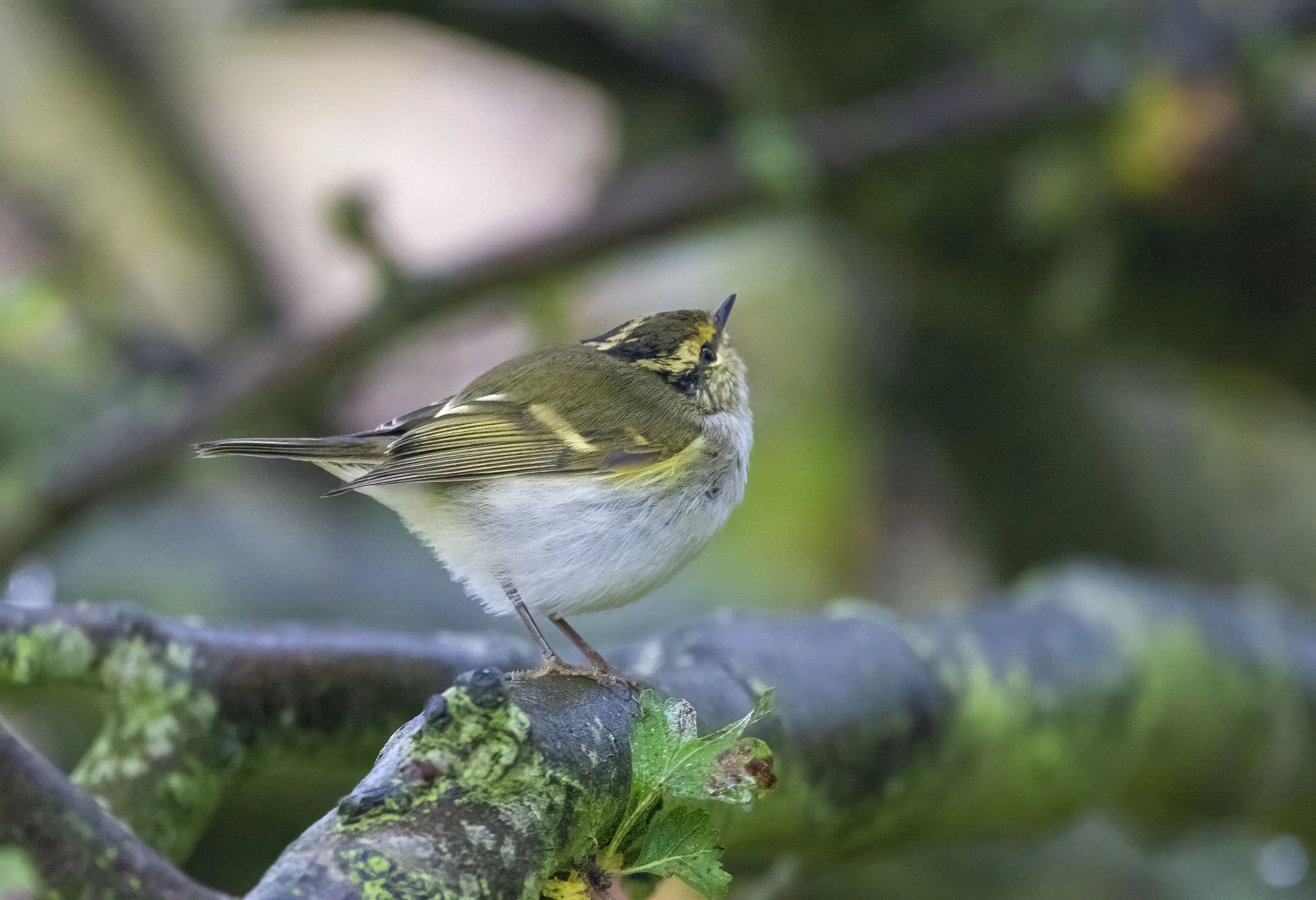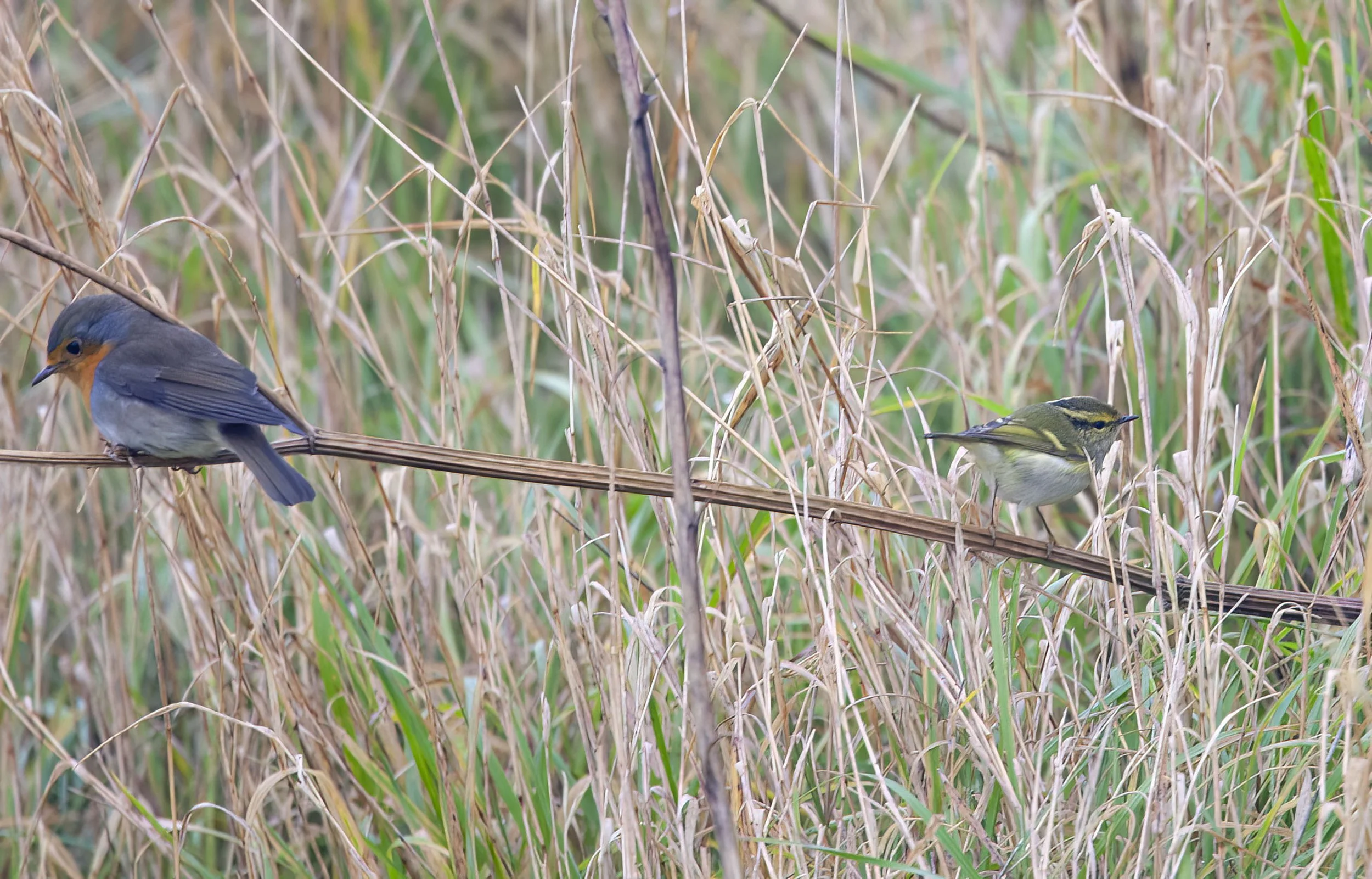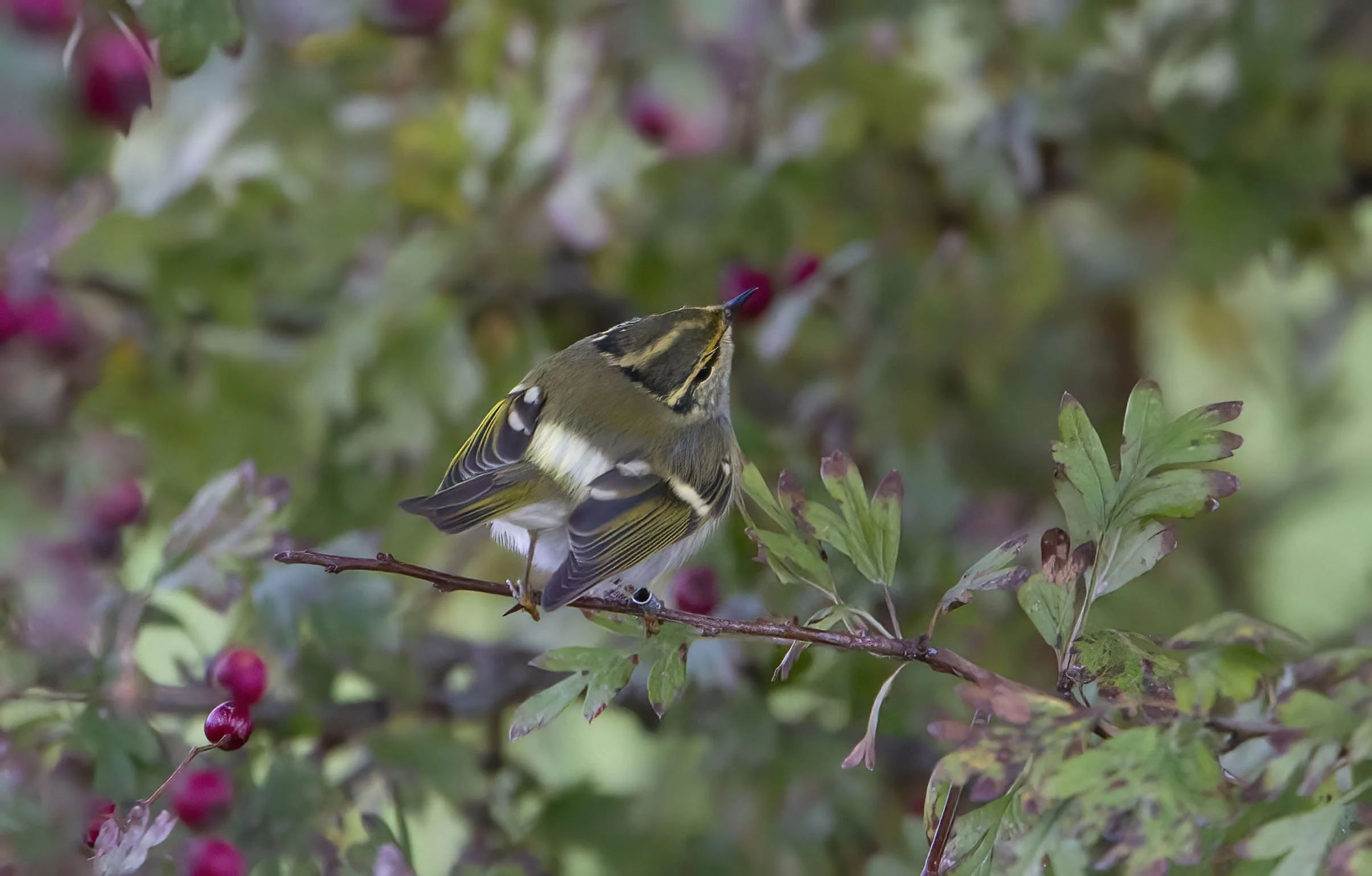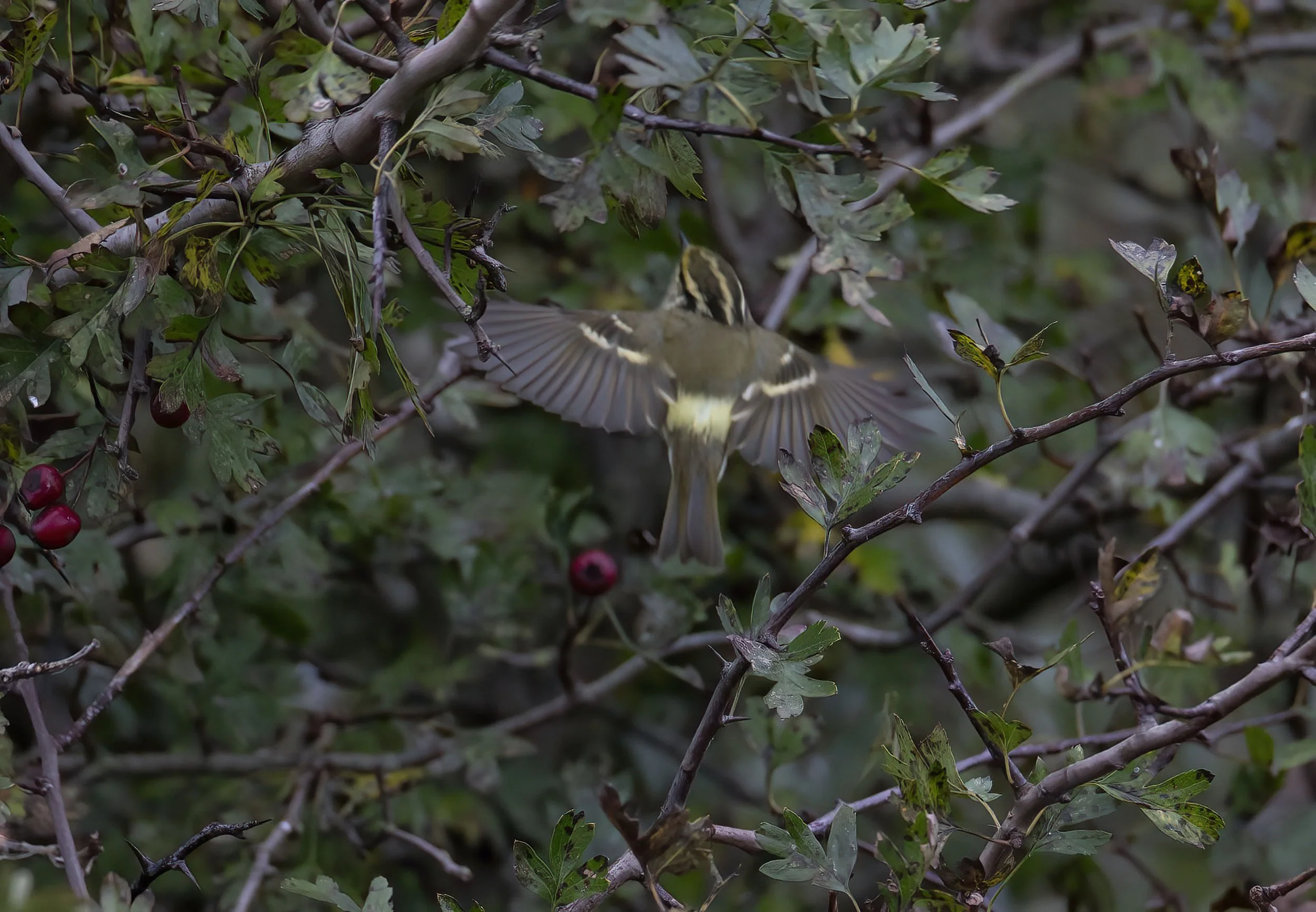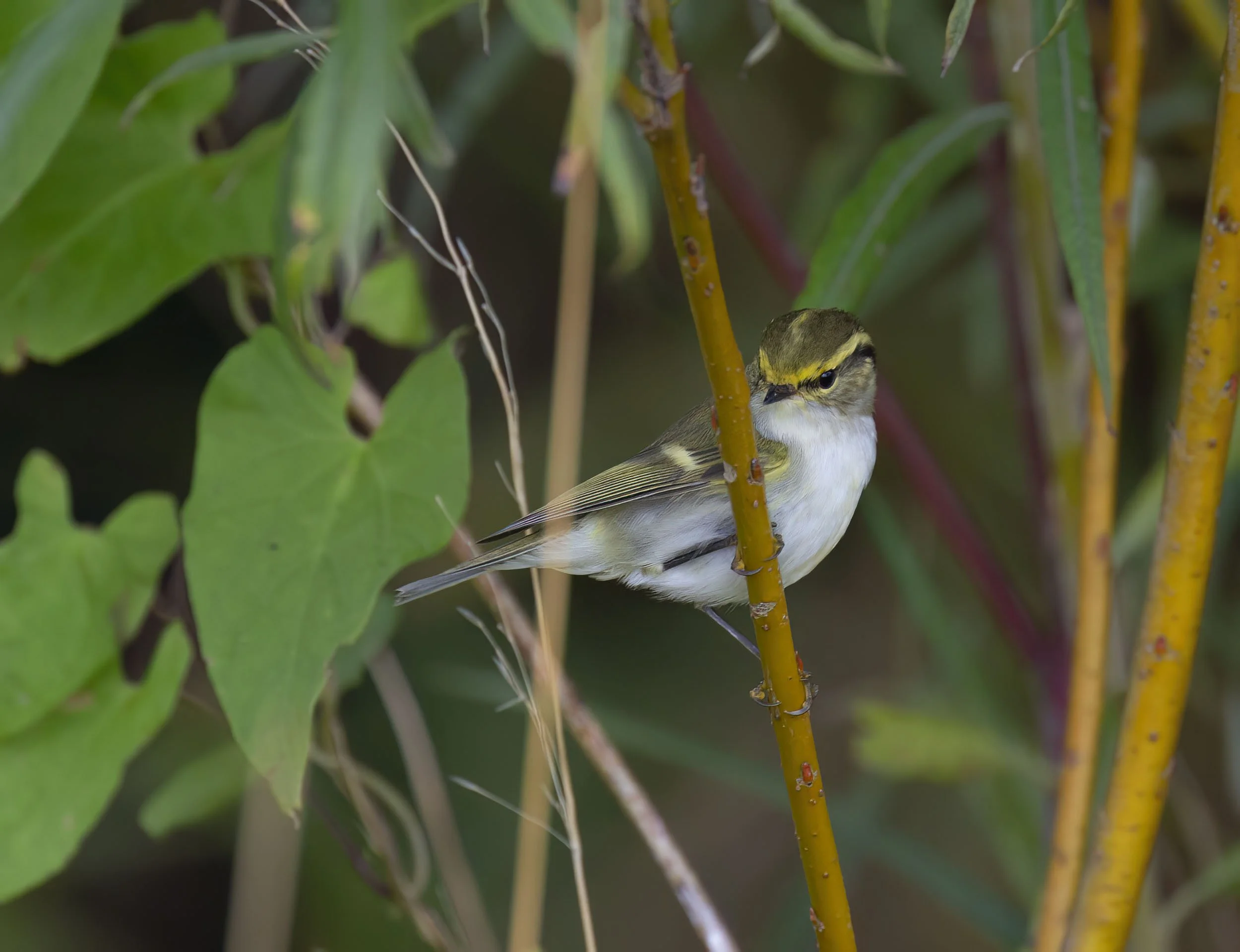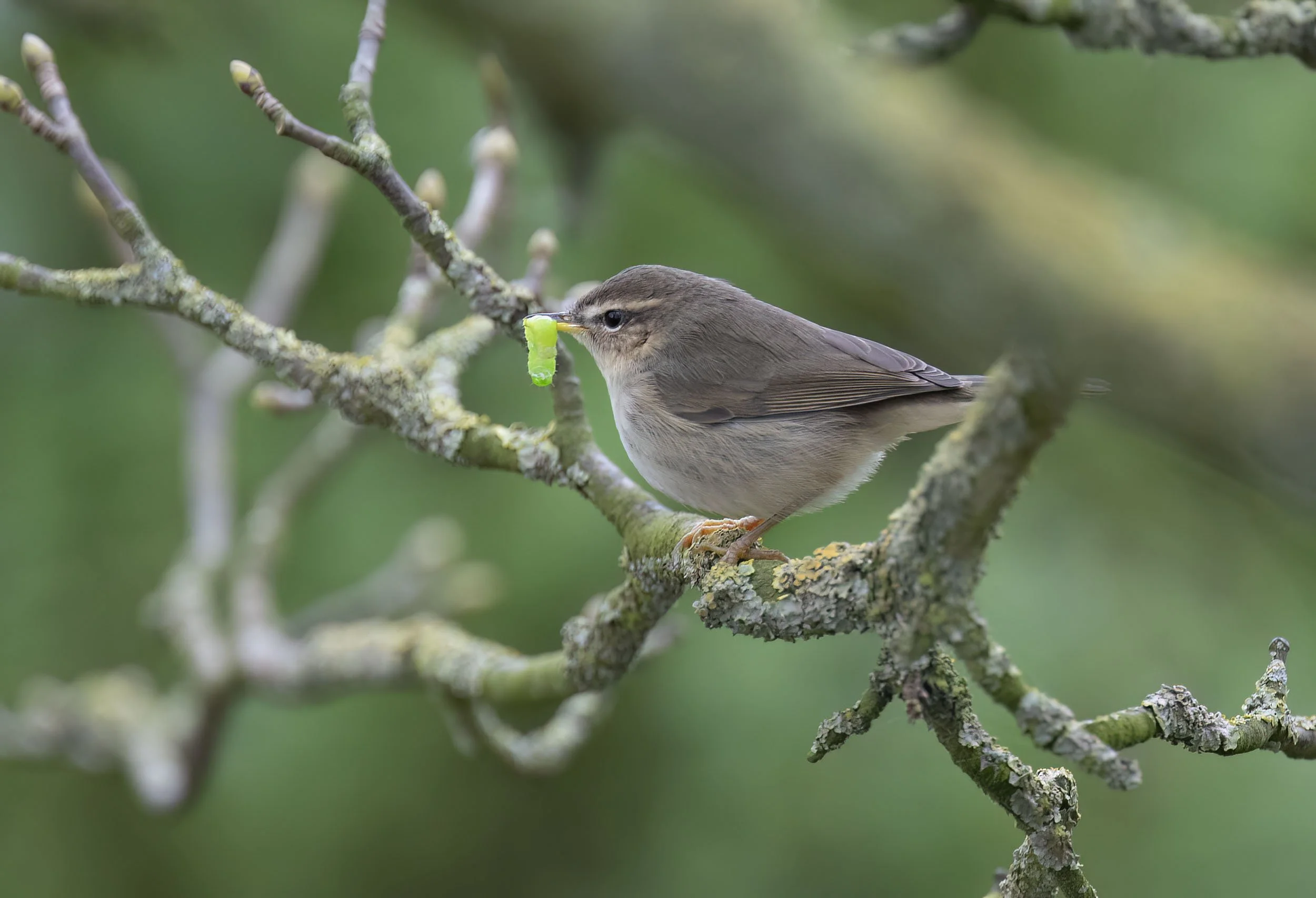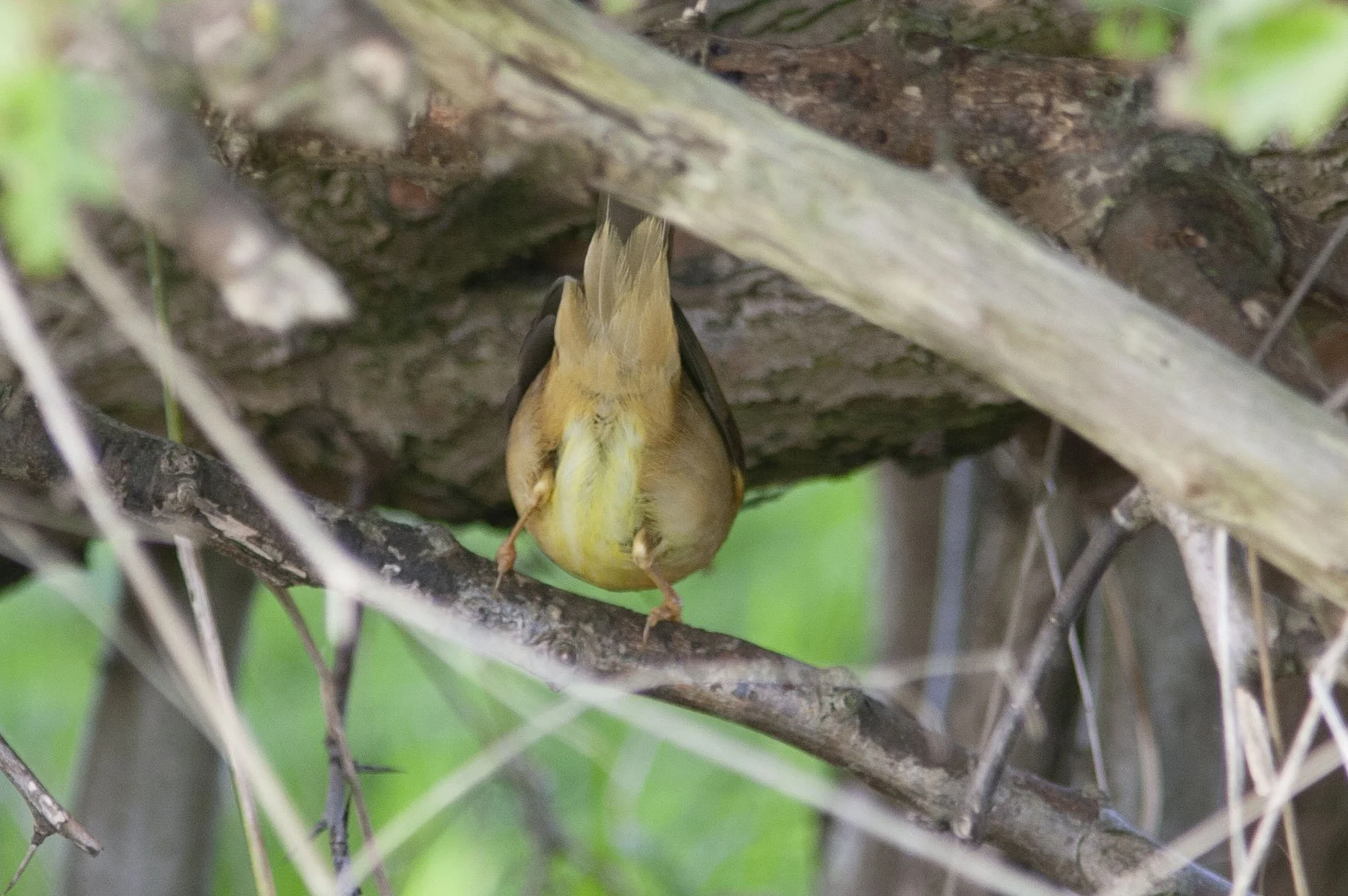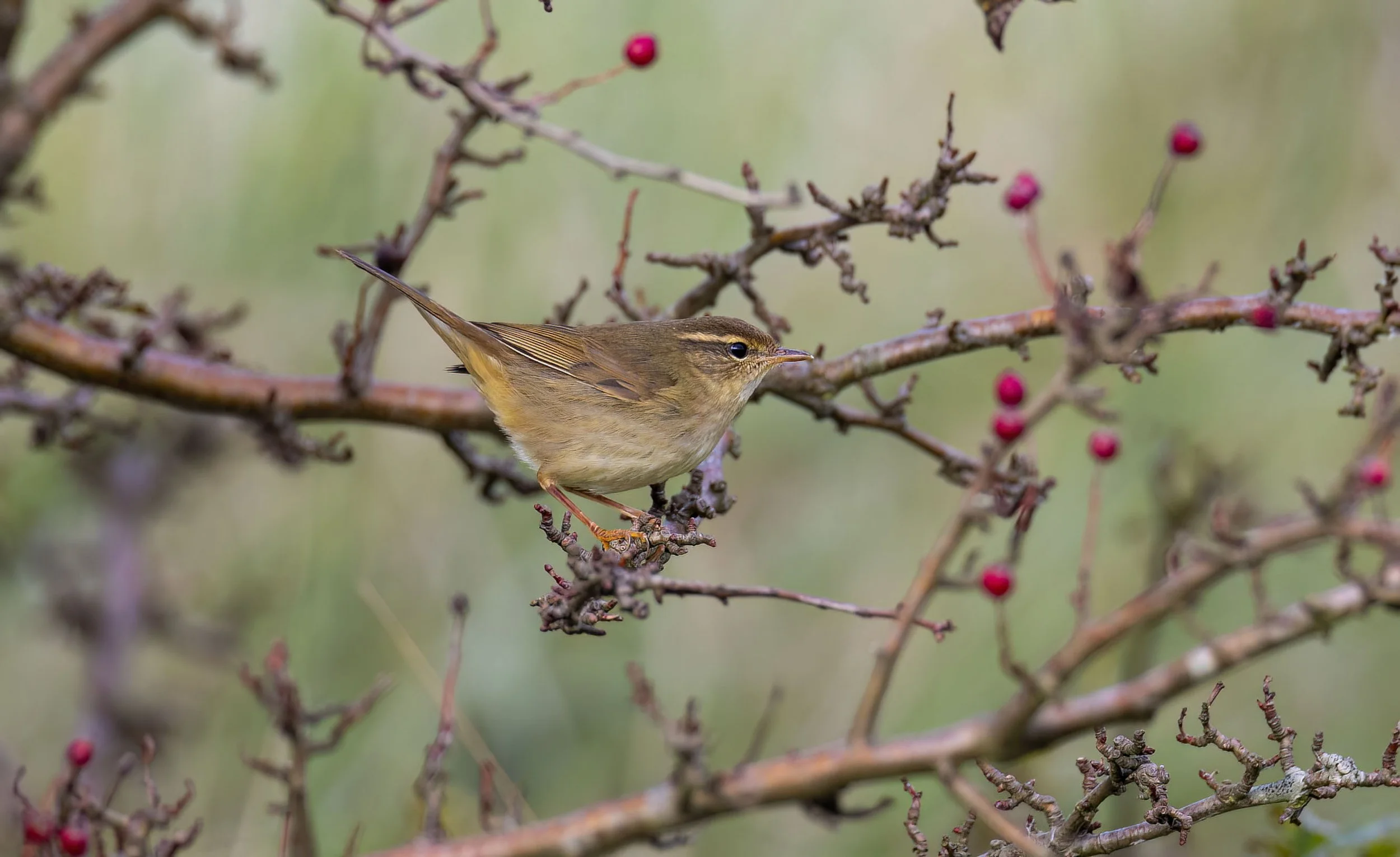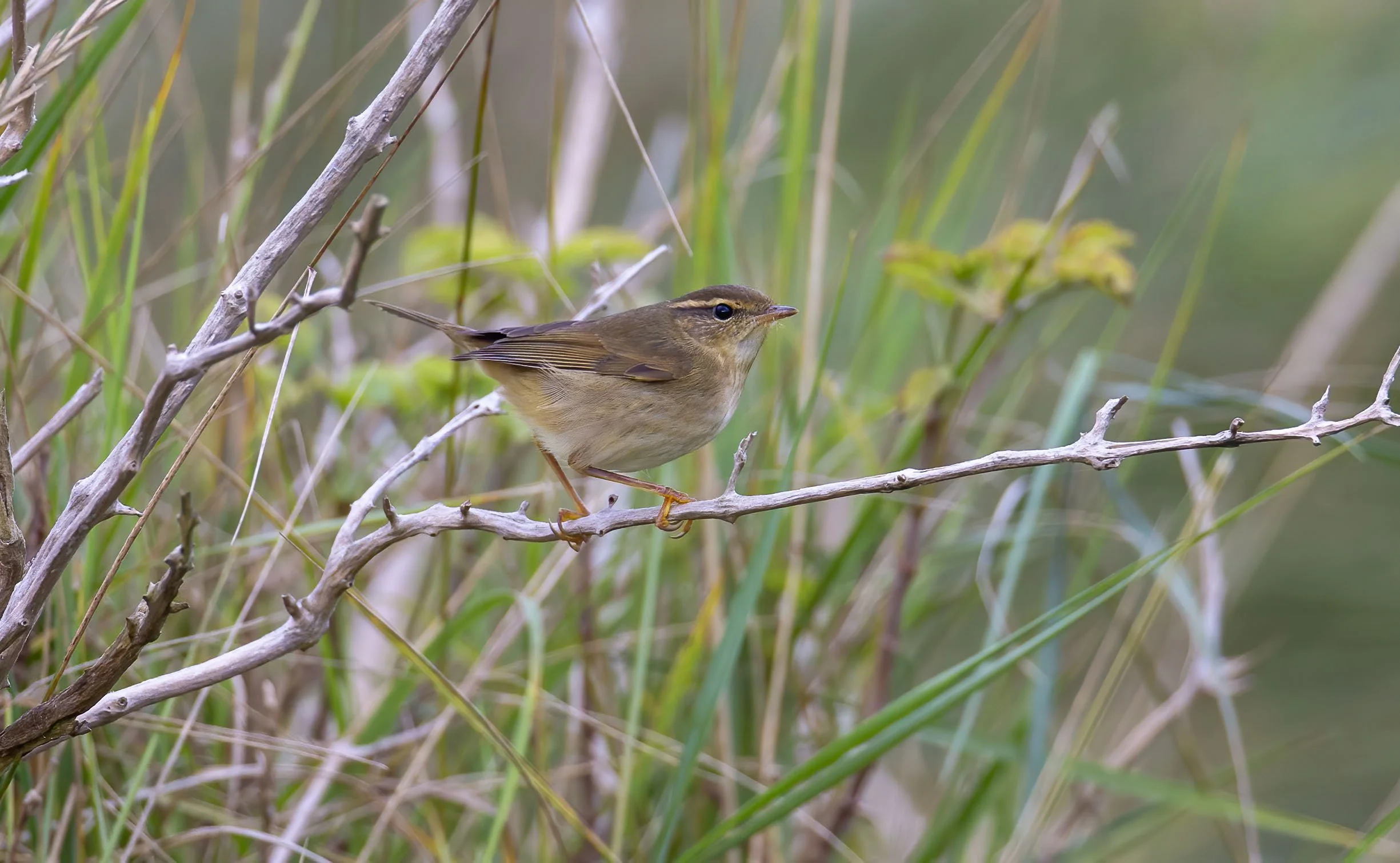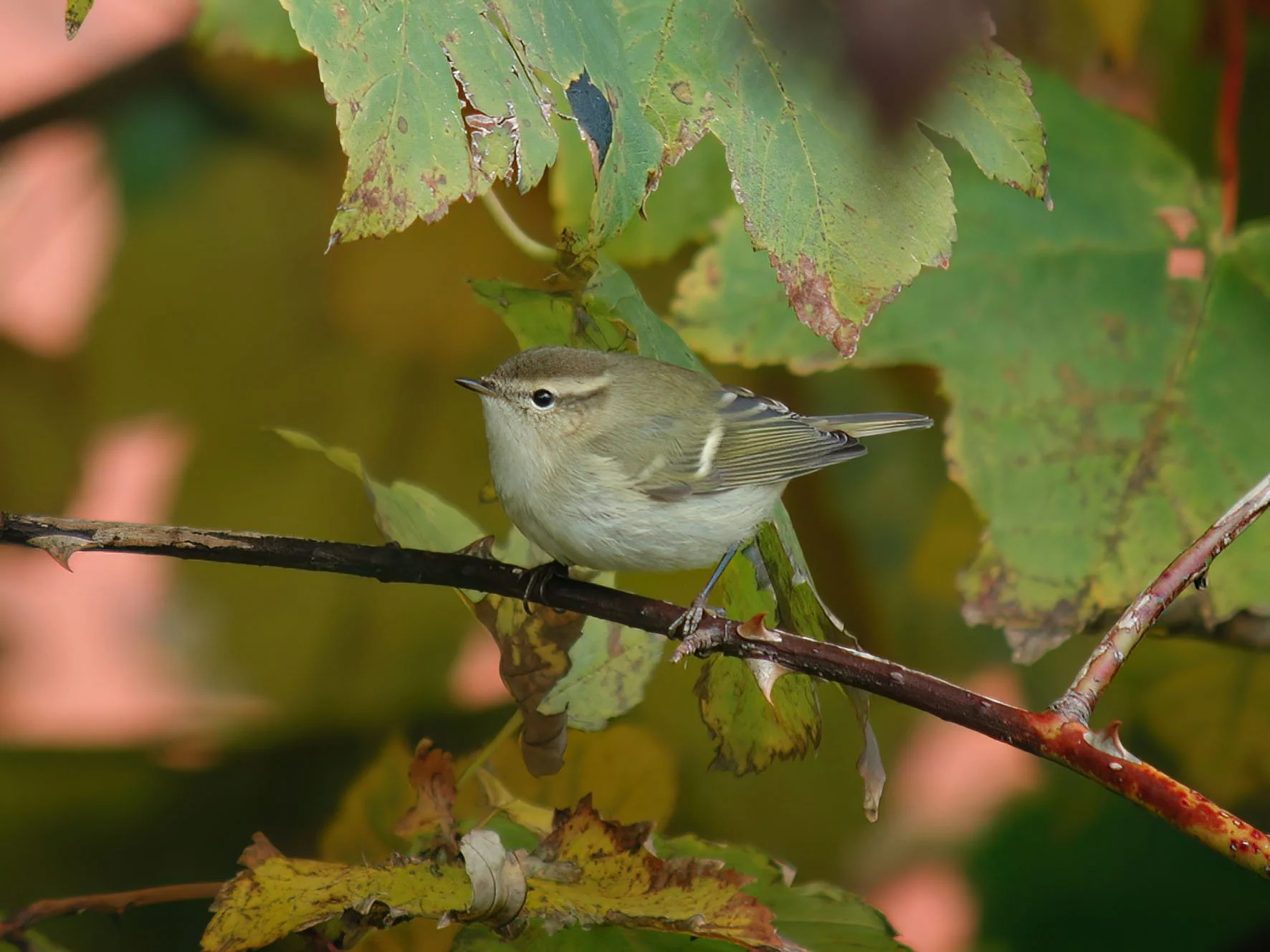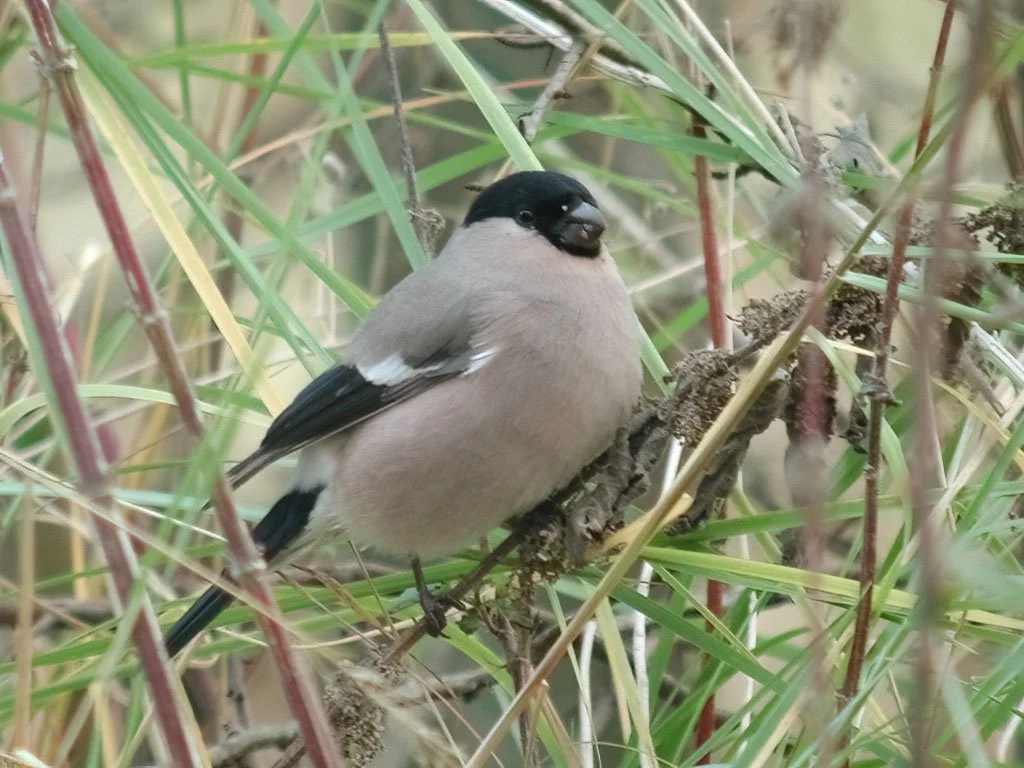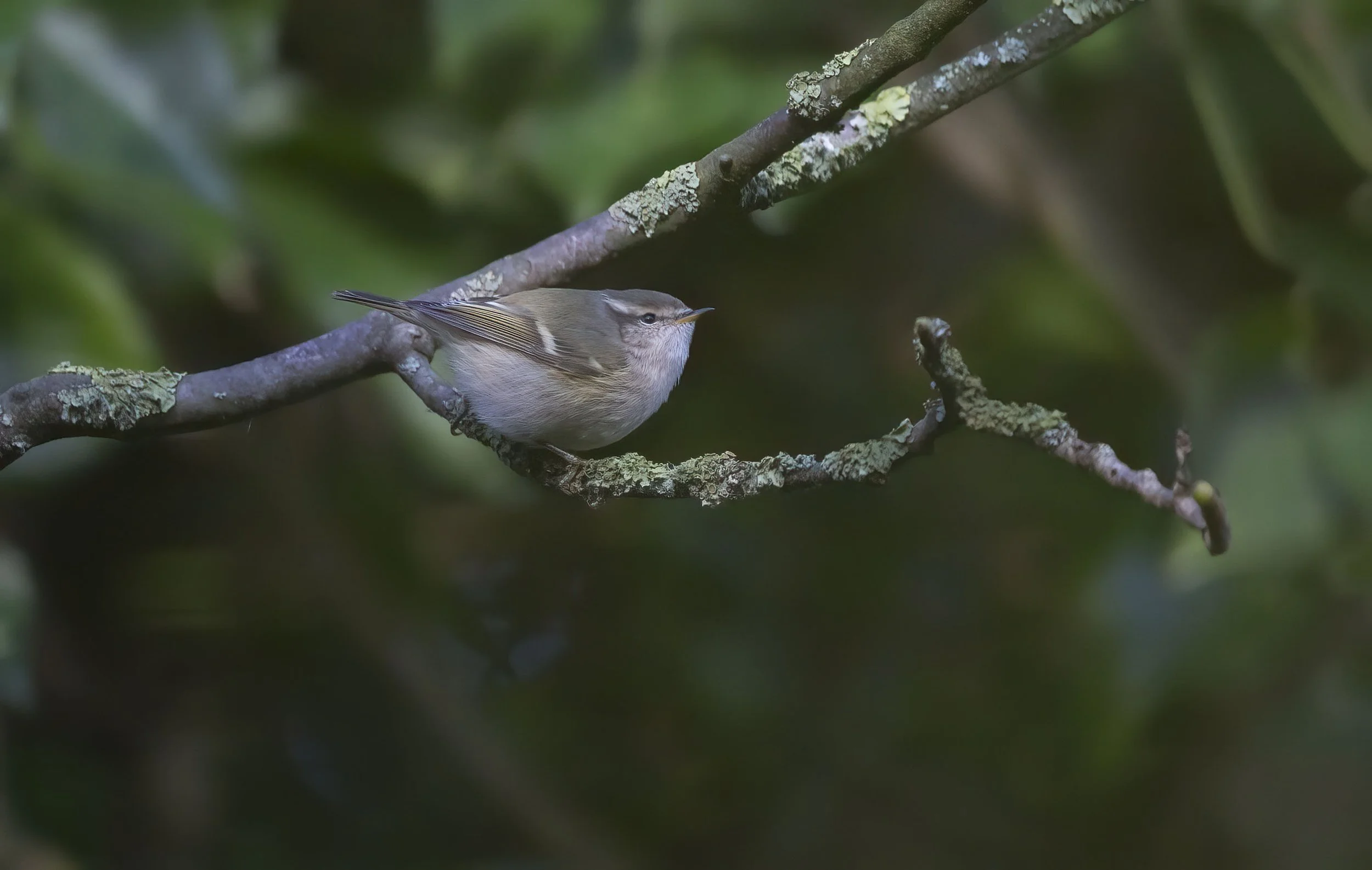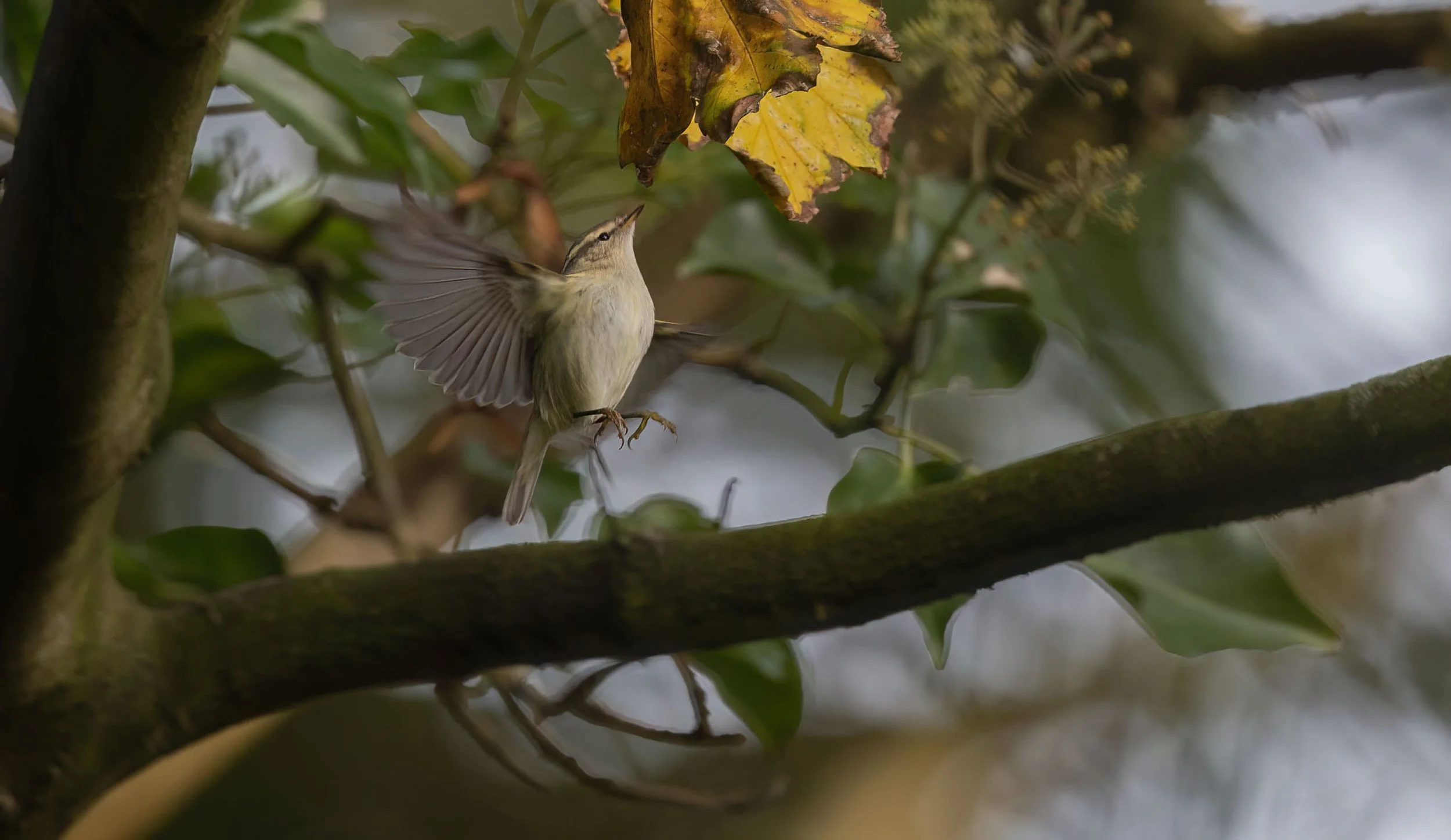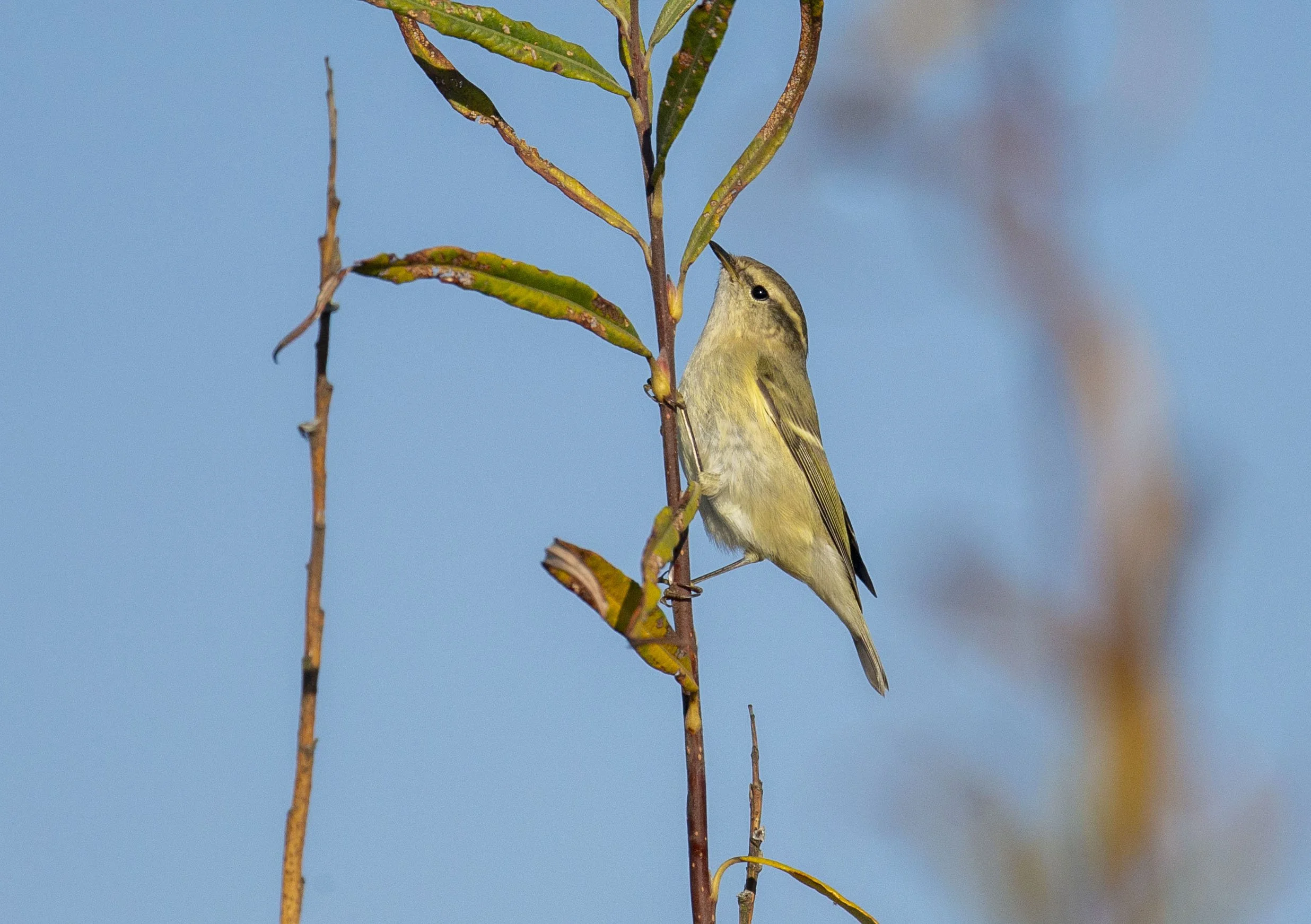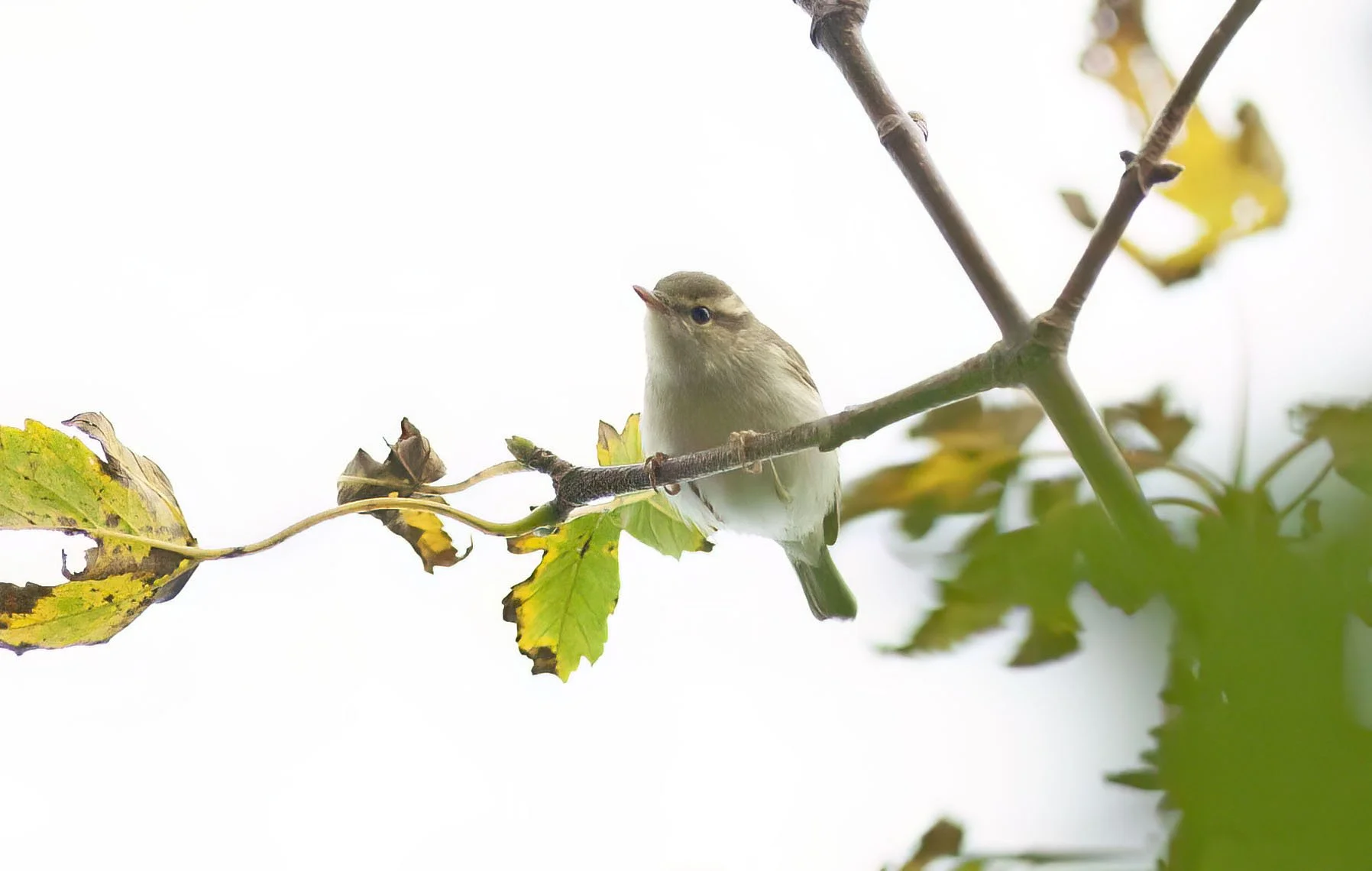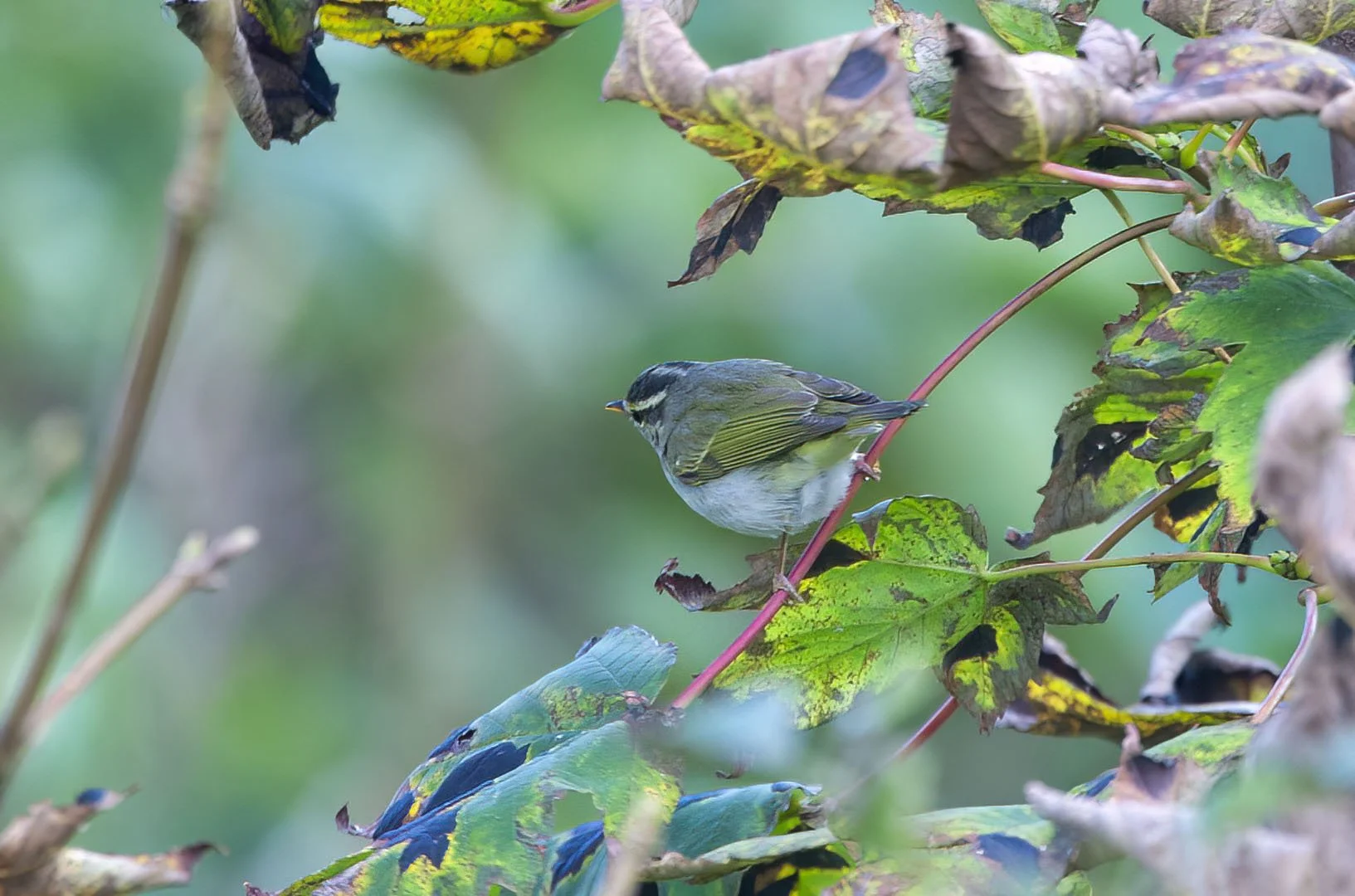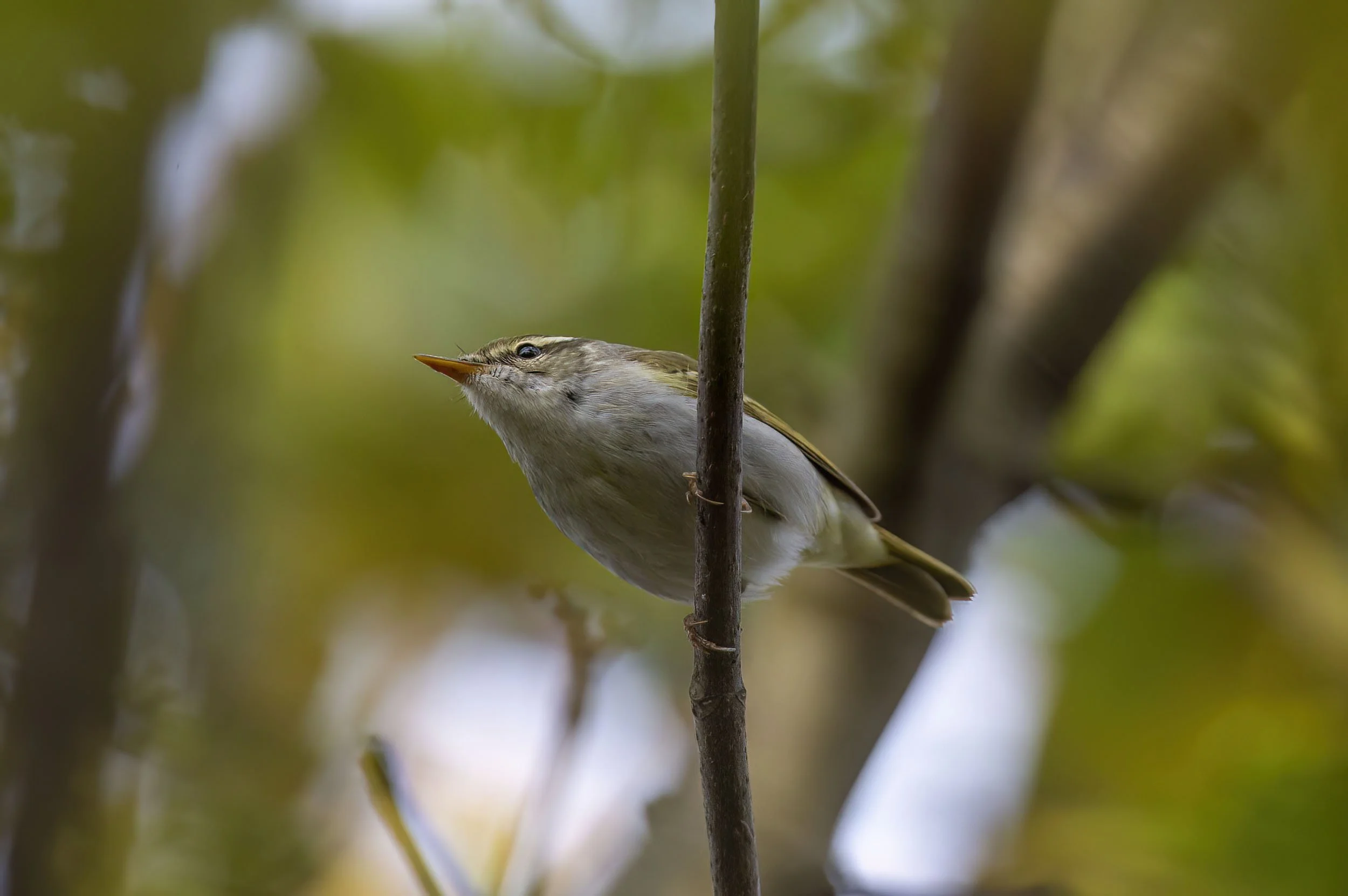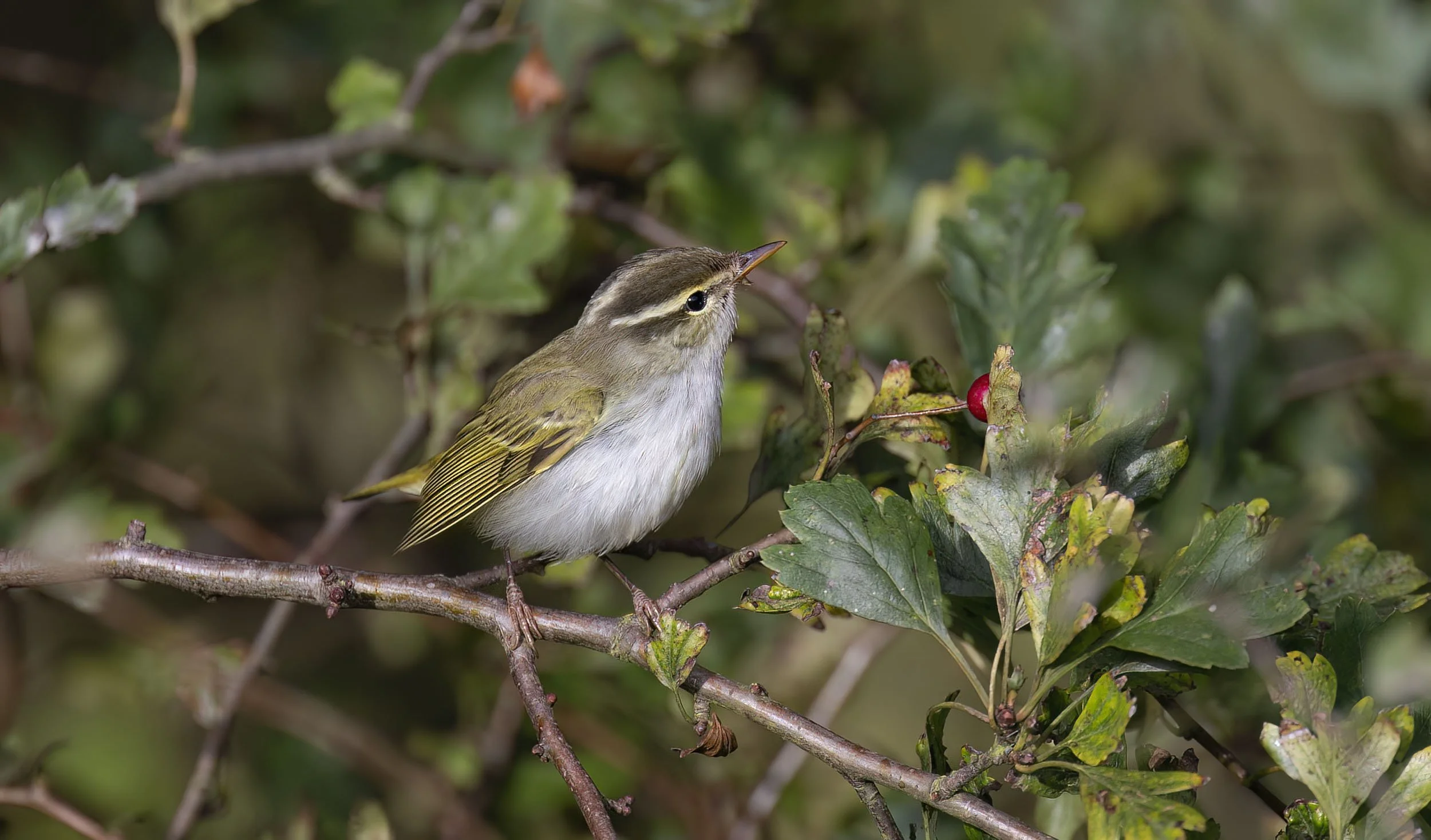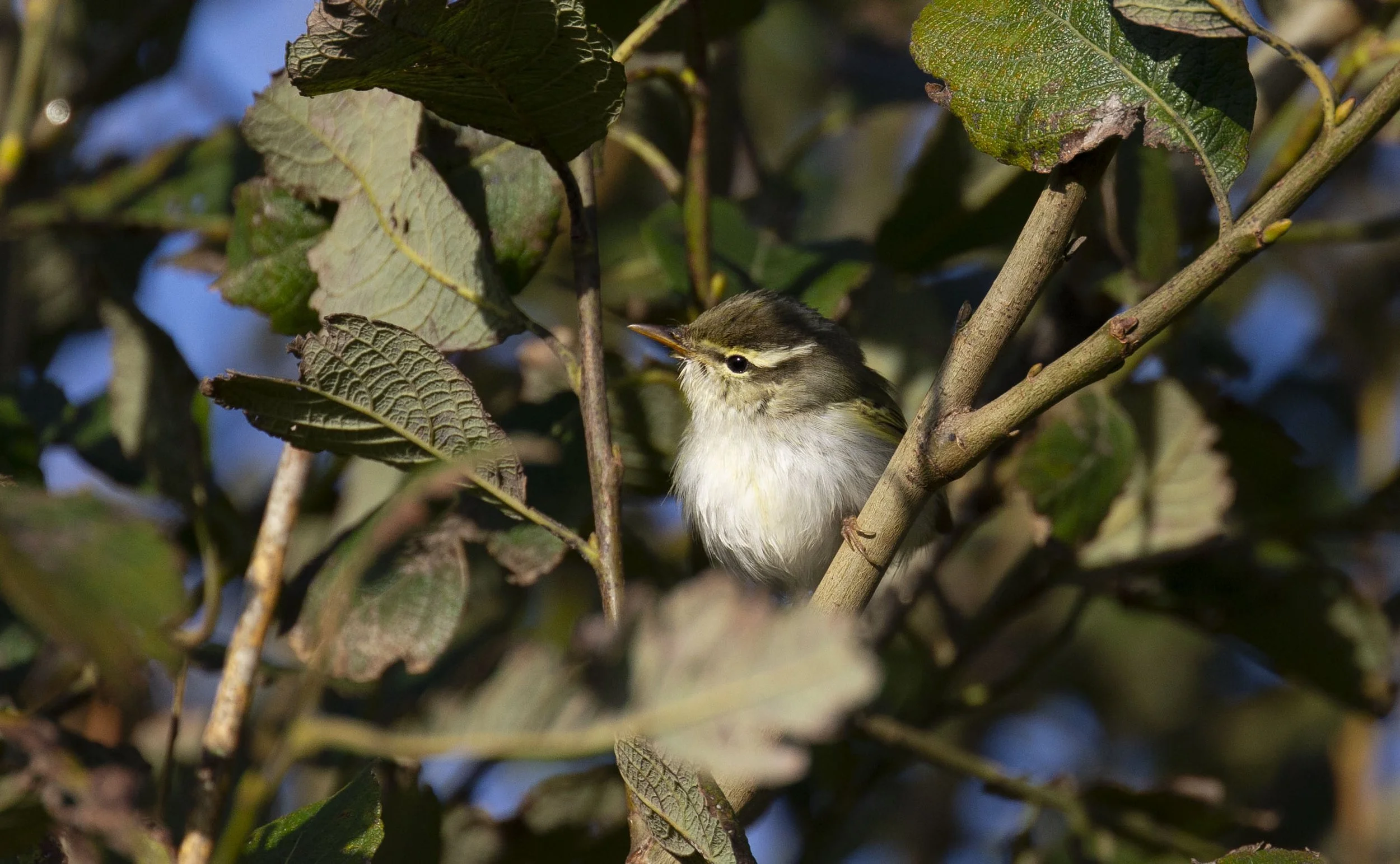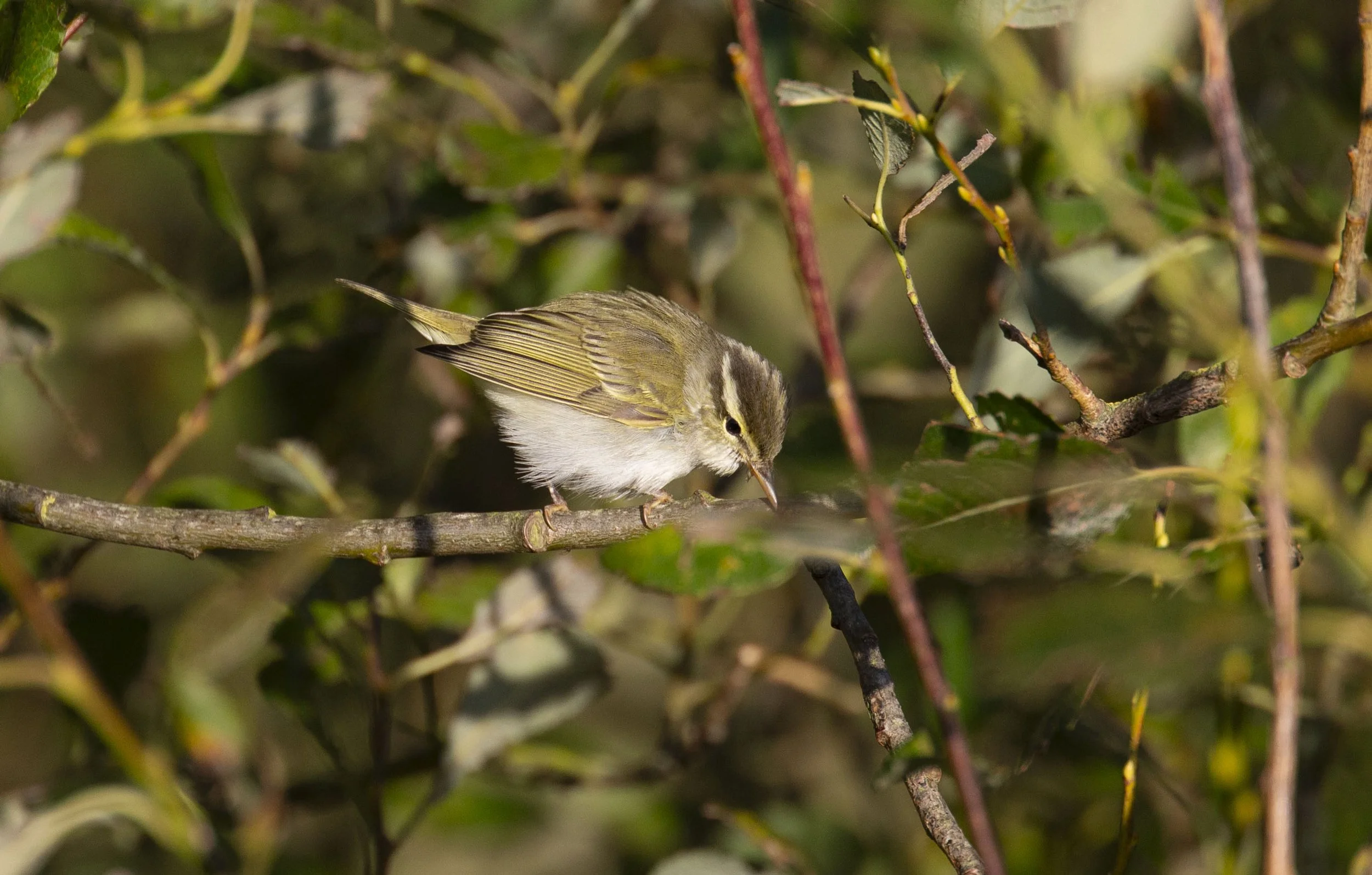Eastern Phylloscopus Warblers - a ramble through time
Musing on my worst autumn ever and dreaming of eastern sprites I wandered back to my Yellow-browed Warbler history; a quick check revealed that I had seen a total of 214 in Britain with 118 of these having been obtained in Lincolnshire: obtained of course being very different to the context of those early birds in the 1800’s and early 1900’s that befell the shot of coastal collectors with Caton Haigh bagging 11 at North Cotes between 1892 and 1932.
Yellow-browed Warbler Lincs October 2015 - every one is a gem having travelled at least 3000kms to grace our shores
Derek Robinson and Reg May Corringham Woods near Blyton c1970 - Nightingales, Lesser Spotted Woodpeckers and the occasional Wood Warbler were still breeding - Reg was one of the first of the true birdwatchers in the county with records in LNU reports back to 1929
My first Yellow-browed Warbler was at Rimac on October 12th 1969. I remember it well or at least I thought I did: It was my first trip to the exotic sounding Rimac a place somewhere on the Lincolnshire coast that was well outside of my area of expertise that up to that point had included summer family trips to Mablethorpe and Skegness centred upon sailing ponds where I could sail my model yacht. Somewhere around 1969 it had come to the attention of the local, older, birdwatchers, and there were four in my home village of Goxhill, that I was interested in birds. On October 12th I recall travelling with Derek Robinson and Doug Wright to pick up Reg May, the grand old man of Lincs birdwatching from his home in Limber, before we headed down to Rimac arriving late morning the norm in those days. We headed down the famous Willow hedge splitting up to cover both sides of the hedge and my notes for the day mention no migrants other than Goldcrest and a Tree Pipit seen in the same hedge a little further on than the warbler. I remember precisely where the bird was in the willow hedge just beyond the double bend – the hedge was a lot thinner than it is now with young willows that you could see through. The warbler caused some elation as it was the first my older colleagues had seen – this was a very rare bird in the 60’s and I was very fortunate to have seen it on my first visit. But the bird was tinged with regret about not having been present the previous weekend when Derek and Reg had seen a Lesser Grey Shrike in the hedge inland of the willow hedge. 56 years later and I have still never seen a Lesser Grey in Lincolnshire. But back to the Yellow-browed Warbler – I thought I would dig out my notes to just check what I had written. The description was fairly brief befitting my 16-year-old lack of precise identification knowledge but is reprinted below:
Feeding with Goldcrests in willows: very small – showed short blackish tail – very prominent yellow eye stripe – lower wing bar very long and prominently yellow – upper stripe sometimes un-noticed appeared short – yellow rump
Allowing for the fact that I didn’t know eye stripes from supercilia and I was probably still using my original Prinzflex 8x30 binoculars (a Dixon’s store special) there still appears to be a distinct discrepancy here with regard to that rump and maybe also the short tail? Could this have actually been a Pallas’s Warbler? A species almost unheard of at the time certainly in Lincolnshire terms where the first two county birds had only been trapped the previous year. So, a conundrum and one of the dangers of looking back in time. I did not see another, or my first Yellow-browed Warbler until October 19th 1974 when ensconced at UEA we travelled to the Holy Land of Wells – Holkham Woods seeing this sprite, not twitched of course as you never knew what was about until you got there in those days.
An actual yellow rump Pallas’s Warbler Lincs November 2008 but is that what I saw in 1969 or was it a brighter rump - I will never know
The following autumn I was working for the BTO at Tring for a short spell and in the glorious Eastern autumn I had hitched from Tring to UEA on the Friday night to join my old buddy, Duncan Brookes. Hitch hiking was in those days still commonplace but was of course always fraught with lack of positive outcomes and you actually never knew whether you would get anywhere let alone when but on this Friday night session I had managed a couple of lifts, one with a dodgy seeming lorry driver and ended up still a long way from Norwich when an old lady in a vintage Morris Minor stopped; after giving me the first degree and getting my life history she eventually said hop in I am going to Norwich! Big stroke of luck. The previous weekend I had hitched up to Eyebrook Reservoir chasing a Killdeer; arriving after dark in some unpleasant weather some locals took pity on me and allowed me to sleep in their stable with two horses!
For anyone not aware of the trials and tribulations of hitch hiking and taking birding hitching to the extreme I can thoroughly recommend Kingbird Highway by Ken Kauffman
https://www.nhbs.com/kingbird-highway-book
It is US based of course but a cracking read and passage back to a very different era.
Back to sprites and news of rare eastern warblers at Holkham had filtered through to UEA and on the Saturday morning October 18th we headed north on Duncan’s motorbike to Holkham in search of a variety of eastern vagrants that had apparently included a Dusky Warbler! I had heard of Dusky and Radde’s Warblers through my acquisition of the Popular Handbook of Rarer British Birds that complemented my bashed copy of the Popular Handbook. Within the pages of said rarer Handbook was a mind-blowing plate of the mythical Red-flanked Bluetail but the text on this and Radde’s Warbler had been etched in my mind for many years – Radde’s Bush Warbler – England – One North Cotes, Lincs, October 1st 1898 – LINCOLNSHIRE the only British record and so close to home. While under Red-flanked Bluetail -- Great Britain – Three – One seen North Cotes Lincs September 1903 (actually adult male on September 21st). Lincolnshire could produce rare birds - time to gen up and get out there.
Radde’s Warbler North Cotes Lincolnshire October 2006 within spitting distance of Caton Haigh’s first for Britain a mere 108 years earlier
An unusually obliging individual
One of the advantages of working at Tring was access to the whole library of British Birds and I assiduously read and re-read and then photocopied all relevant identification articles and articles on finds of British firsts to fifths as these were then all published. The December 1972 paper Field identification of Dusky and Radde's Warblers R. J. Johns and D. I. M. Wallace with its exquisite pen and ink sketch by DIMW was duly at the forefront of my mind in that mid-October visit. On arrival we came across a small crowd, maybe 15 - 20 people looking for a Radde’s Warbler that had been seen on the side of the main path but it was elusive so we wandered off avoiding human contact even in those days but managed to connect with no less than four Yellow-browed Warblers and my first Great Grey Shrike of the autumn amongst an impressive fall. Wandering back past the Radde’s location the bird was being seen in flight crossing the path but we quickly realised it was feeding under a small clump of silver birch and a bit of combat stealth soon saw us sitting in the middle of the trees mixed with Willow herb and reeds, hidden from view; the Radde’s was totally unconcerned and fed within 10 feet of us chuck chucking away, negating the use of bins and the way to see a new bird. The following day we were at Cley with a Rough-legged Buzzard and Short-eared Owl arriving off the sea and 300 Twite accompanied by six Lapland Buntings and a strange bunting that we never did identify; Like a small Reed Bunting with heavy blackish streaking and white moustachial stripe but most noticeable was a white shoulder patch that was even visible in flight. We didn’t see the Dusky Warbler or the Black-throated Thrush that entertained later in the week but the return hitch to Tring went much more smoothly.
Radde’s can often be tame but highly unobtrusive needing time and patience for good views - the thought of a Radde’s at Holkham with 15 or so would be observers today would be beyond belief with more like 50 or so noisy people chatting about their latest birding holiday or new camera - a different era
Back in Lincolnshire my first (or second) Pallas’s Warbler was twitched at Saltfleet Haven on October 30th and 31st 1976 but its shiny leg iron was a bit of a downer and I had to wait another three years before finding one with Mick Mellor in the willow hedge at Rimac on October 27th – 28th 1979. A week later we headed west to Meols to enjoy our first superb Asian Desert Warbler tip tilting on a low fence one of my most memorable rare birds – still trying to find one in Lincs. My notes rather more extensive than nowadays when I tend to rely on the camera!
Another brilliant bird; first seen in flight - very pale plumage with prominent white outer tail feathers very obvious. Bill fine pointed pale yellow with dark culmen ridge – head dull pale sandy- grey same on mantle with slightly darker ear coverts forming the only noticeable pattern – Eye very prominent pale lemon yellow iris with dark pupil. Throat and underparts dull creamy – greyish colour. Wings slightly darker sandy-grey-brown with narrow rufous edges to tertials and narrow rufous wing bar on tips of greater coverts. Rump, uppertail coverts rich reddish-brown rest of tail duller reddish-brown with brighter central feathers and prominent white outers. Legs pale straw-yellow quite long and strong looking. In shape and jizz like Spectacled or Subalpine, small with longish tail and dumpy body. Flight was low, fast and direct when it looked greyish with rufous rump and striking white outer tail feathers. Fed in some low bushes, on the ground and amongst various low weedy vegetation, nettles etc. constantly on the move. On the ground crawled about in low vegetation and often difficult to see but tame. Characteristic action when seen on the ground or perched was alternate up and down bobbing of the head and tail giving the impression that the bird was pivoting in the middle looking as if it was falling off the fence.
The 1976 Saltfleet Pallas’s Warbler taken with the old manual focus 400mm Sigma lens and a Nikon F301 camera
Lincolnshire Yellow-browed records commenced in 1980 with one suitably at Rimac on October 11th and the same site produced my latest ever in the almost leafless willows of the same hedge on November 14th 1981 – no call heard but I did note that it was a very bright green bird so I must assume it was not a Hume’s! After a big influx in 1985 I even broke into print in the esteemed British Birds co-authoring a paper with Jeff Baker who I had lodged with in Tring back in 1975
- https://britishbirds.co.uk/journal/article/yellow-browed-warblers-britain-and-ireland-1968-85
My only foray into the Northern Isles in autumn on Sanday, Orkney September 28th to October 2nd 2003 turned up a minimum of 11 Yellow-browed Warblers somewhat outshone by our first selfie Lanceolated Warbler, at the time only the second for Orkney in spite of the Shetland domination of British records.
Lanceolated Warbler Start Point Sanday September 2003 - its in the grass and survived to tell the tale unlike the North Cotes bird of 1909
In the absence of a decent camera
As coastal records of Yellow-broweds increased it was time to locate a local patch bird and October 10th 2005 duly obliged with one located calling and showing occasionally on Waters” Edge at Barton – amazingly two were present on 15th and further birds followed in the same area on October 3rd 2007 with two again on October 16th 2014 with one nearby on October 18th 2024. In the interim I found one on my old stamping ground at Dawson City in Goxhill Marsh on October 3rd 2012.
Yellow-browed Warbler Waters’ Edge Barton October 15th 2005 one of two birds present in the same location on my local patch that day
Same bird in different light
Dawson had produced many of my formative views of a wide range of species firsts from Lesser Whitethroat to Water Rail and Red-crested Pochard as it was within reach of home on a bike. Birding alone new birds had to be identified from the old Collins Guide but finding your own birds and having to work out what they were taught me a lot. Great Grey Shrikes at Dawson on April 2nd 1970 with another that subsequently wintered in the approach hedge in October 1970 and gatherings of Short-eared Owls with eight roosting together nearby in December 1970 proved this location, that had produced Britain’s first ringing record of Little Bittern in 1953, had serious potential. Another spritely occurrence featured a rather smart Siberian Chiffchaff located there during March 11th – 20th 1989 not on this occasion on subtle plumage features but by the fact that it was in song a strange mix of Willow Warbler and Chiffchaff. A slide I sent to British Birds featured in the monthly Marathon Bird photo competition April 2000.
https://www.britishbirds.co.uk/system/files/2025-11/V93_N04_P212_212_M010.pdf
Siberian Chiffchaff Dawson City Goxhill March 1989 scanned from a slide
Fast forward to the easterly autumn of 2020 when a bumper crop of Dusky Warblers occurred in Lincs and a singing Siberian Chiffchaff was in exactly the same area at Dawson City from November 12th – 16th – a truly bizarre coincidence not in the species occurring there but in the fact that both birds were in song and I have not actually heard any other individuals singing in Britain.
Siberian Chiffchaff Dawson City Goxhill November 2020
Stunning little bird - below recordings of this bird on November 12th 2020
Siberian Chiffchaff Dawson City Goxhill November 2020
Prior to these records Dave Hursthouse and I had a striking Phyllosc on the inland trackside from Stonebridge car park on October 22nd 1987 that really had us questioning its ID as it was a very Bonelli’s Warbler like truly strikingly grey and white individual with bright lime green fringes to the secondaries: I recall even doing a painting of the bird that I have subsequently lost. Extremely pale, striking bright bird was distinctive call; Bill fine and quite short held slightly tip-tilted, dark brown on upper mandible and tip with flesh base to lower mandible; pale creamy supercilia ran from forecrown over eye to rear of ear coverts – narrow but obvious; slightly dark line across lores and through the dark eye which had a narrow pale eye ring – ear coverts mottled pale grey brown – crown , nape, back rump and scapulars all uniform very pale grey with the faintest buff tinge – wing coverts slightly darker – fringes of flight feathers quite bright green and formed striking contrast with rest of plumage. Rump possibly tinged slightly greenish but hard to see on active bird – tail feathers grey-brown fringes greeny-yellow. Underparts all strikingly silky white through to undertail coverts – legs blackish. Call a very distinctive and high-pitched peep or cheet short and clipped
Thanks to Dave and his amazing record keeping, and for reminding me that we sent a scan of my painting and notes for additional input as below:A description and drawing by GC was circulated to four birders who we had respect for about their input on phylloscopus warblers, with a request for their opinion of the bird.
Replies from the four contacts made interesting reading.
Andrew Lassey, suggests it could probably be a northern Chiffchaff, thought likely 'tristis', years later described as a race of Siberian Chiffchaff, but certainly not a normal looking tristis. Possibly, from more a northern region. These pale plumaged individuals do not often turn up in UK. Also, AL mentions, he personally had seen a similar type at Flamborough Head but they are extremely rare.
Nick Riddiford’s reply, was similar to AL, suggesting it could be a pale tristis, one of the more northern types, but mentions, tristis does not particularly look like this individual.
Steve Madge reply, "could not rule out tristis, but thought 'orientalis' Bonelli's Warbler was very likely" and suggests we submit it to BBRC.
Killian Mullarney’s reply, suggests probably a tristis of the more northern types
Light makes a big difference to the appearance of Siberian Chiffhcaffs - one here from October 2012 showing more obvious wing feather fringes but duller underparts on a very dull day - Overall I think the 87 bird was one of these very pale tristis
The same bird as above later in the day taken in mist but out in the open away from the wet grass it had been feeding in
The previous day we had found a Pallas’s Warbler at Pyes and another striking Willow Warbler at Ponderosa that I suggested at the time was yakutensis but was probably eastern acredula or even just a variant nominate bird :
Willow Warbler profile with long wings, long tail and prominent bill as well as pale legs. Pale creamy supercilium from bill over eye but only faint contrast with darker eye stripe and mottled pale grey-brown ear coverts. Bill horn with flesh coloured cutting edges and lower mandible. Crown, nape, mantle, wings and rump all dull pale grey-brown slightly darker on tail and wings. All underparts off white with no yellow on carpal and no sign of nay olive or yellow anywhere in the plumage. Legs and feet dull flesh. Undertail looked to have pale outer webs when seen from below. Picking insects from underside of leaves in Sycamore and regularly hovering with body held horizontal and tail spread. No call heard.
I have managed to see a total of 63 ultimate sprites Pallas’s Warbler to date and every one a gem with a best day finding three in quick succession near Pyes’ Hall on October 21st 1988, eight in total in autumn 1994 but still waiting for a local bird.
https://www.grahamcatley.com/blog-1/tkw5rnzh58hk1g7r40kd2bp17u9dtk
Pallas’s Warbler Pyes Hall November 4th 2008 one of three present in the area that day
Pallas’s Warbler and continental Robin Pyes Hall November 4th 2008
Pyes Hall October 11th 2010 showing off its full range of stripes and a leg iron but from where?
Pyes Hall again October 2014 - this migrant hot spot destroyed by the Environment Agency sadly is no longer a phyllosc magnet with dead and dying remnants of its former trees and bushes
a bird the size of a Goldcrest can quickly disappear in a few hectares of sea buckthorn
Donna Nook Stonebridge car park October 2016
October 19th 1980 saw me once again wandering round Rimac in the knowledge that there were multiple Pallas’s Warblers just across the Humber but after a full day of slog I had found 10 Goldcrests and a Blackcap then at the last gasp Lincolnshire’s first Olive-backed Pipit popped up in front of me where else but in the magical willow hedge. My first twitched Dusky Warbler also came in the autumn of 1980 at Donna Nook on November 3rd with a revisit on 6th and my first self-found bird was just down the road at Saltfleet on October 19th – 20th 1990 during a magical fall and remains the only rare bird I have ever produced by pishing without knowing it was there. Still slogging Waters’ Edge at Barton for a Dusky as the habitat has real potential for a wintering bird and they have increasingly been found inland in recent winters.
Dusky Warbler Sea View Saltfleetby October 2020 in typical low vegetation
An over-wintering Dusky Warbler at Wolla Bank January 2019 with a nice juicy caterpillar
Reverting to the Radde’s connection that North Cotes bird in 1898 remained the only British record until 1961 when one was trapped at Cley by Richard Richardson who we got to know well during many soujourns on the East Bank in my three years at UEA; it was also the only Lincolnshire record until 1988 but one I had at Donna Nook on October 3rd 1987 that was deemed inadmissible by BBRC; for the record these are my notes on said bird: Yes it was without bins but at 5 feet I think my eyes were reliable at that time at least.
Views only with naked eye but at close range: flushed out of 4 foot high buckthorn mixed with bryony as I brushed past it – crawled out of the top of the buckthorn five feet in front of me and flew short distance before diving back into buckthorn; five minutes later while peering into a gap in the buckthorn it began to descend from the top of the buckthorn canopy showing its legs and undersides before disappearing again – about an hour later it was again seen briefly crawling away through the bottom of the buckthorn: very prominent long creamy white supercilia above a dark eye stripe – all upperparts a dark olive-green with more yellowish tinged rump – short rounded wings and longish broad tail in flight which was whirring – underparts yellow-ochre with orangy undertail coverts – legs seen when crawling out of buckthorn were strong, quite. Thick and yellowish. Crawled about in cover not flicking around like eg Chiffs;
Radde’s Warbler Horseshoe Point, North Cotes 2006 - the second bird I ever saw at Flamborough in October 1982 gave us a view similar to this in Old Fall hedge but I didn’t count it - another was in the bay brambles later in the day - a very similar view to the 1987 Donna Nook bird in the first instance but lets face it unmistakeable
It was the magical spell of mid-October 1990 that produced my first acceptable as it were record between Stonebridge and Pyes Hall on October 21st. The events of the 18th were transcribed in Birdwatch (see below) and in the ensuing three days I must have walked that stretch of the coast about 20 times amassing an impressive list of eastern goodies but the Radde’s found on the 21st fell to Andrew Harrop, we must have walked past it earlier! The Caton Haigh connection came ten years later after we had found a Radde’s at Pyes’ Hall on October 1st 2000 then completed a two Radde’s Lincs day with a twitch to Horseshoe Point for another bird found by Howard Bunn. The same spot produced another Radde’s found by the inimitable Dave, Bradders, Bradbeer on October 12th 2006. The latter two survived their encounters with humans unlike the 1898 bird described below:
John Cordeaux of Great Cotes (1899) in the new series of The Naturalist, Vol. XXV. p. 23, says: 'At the meeting on 19th October of the British Ornithologists' Club in London, Mr. Haigh exhibited an example of this East Siberian species, which, after much careful watching, he obtained on 1st October from a hedge at North Cotes, near the coast. Mr. Haigh was first attracted by the very peculiar and loud note of the bird, which he said was equal to that of one several times the size, and it is curious that the Russian Godlewski makes mention of the same fact. L. schwarzi has hitherto not been recognised west of Tomsk in Eastern Siberia, so that its occurrence in the Humber district is the more remarkable. The bird will shortly be figured and described in the Ibis.'
Radde’s Warbler between Stonebridge car park and Pyes Hall October 14th 2014
Radde’s are ground huggers and the chances of finding one in the vast areas of sea buckthorn on the Lincolnshire coast are minimal which probably explains why three of the 11 I have seen in Britain have been within 100m of one spot in the dunes between Stonebridge and Pyes Hall with another two within 1km of the same spot.
This little cracker was present at the same time as an Arctic Warbler in the car park bushes
Arctic Warbler Donna Nook October 2014
grass and a few scattered bushed offer a better chance of locating a Radde’s
The autumn of 1985 produced my first Hume’s Warbler at Spurn on October 27th but we had to wait until 2003 for a Lincolnshire example at Gibraltar Point where I saw it on 25th and 28th even managing to get a reasonable image with my digi-scoping gear of the moment. A cracking female Northern Bullfinch was very close by on 28th. Another Hume’s in the plantation at Gib Point on December 4th 2013 was followed by three at Bempton – Flamborough between 2016 and 2019 but a found bird still eludes me.
Hume’s warbler Gibraltar Point October 2003 - digi-scoped - I was amazed to get the scope on a fast moving phyllosc and get it in focus in a decent pose - the Nikon E880 I used had a three Megapixel sensor
the female Northern Bullfinch next to the above Hume’s October 2003 Gib Point
Hume’s warbler under a very shady canopy on a dull December day Gibraltar Point December 4th 2013
same bird as above
Hume’s Warbler Gib Point December 2013 - if they call you stand a chance but a bird in the canopy is tricky
Hume’s warbler Flamborough October 2016 - a classic individual
same bird as above but in bright sunlight which can produce a different appearance in upperpart tone
Hume’s Warbler Bempton November 2019
Same bird as above Bempton November 2019
Rare Phylloscopus warblers were formerly an identification challenge to would be finders before the days of digital photography and modern recording equipment. On September 20th 1976 I had made the long treck in my Mini Clubman to Gibraltar Point in search of my first Arctic Warbler in Syke’s Farm. Being a weekday needless to say I was the only person there looking but its frequent calling from the tops of the old sycamores made locating it quite easy! A month later we were camping at Wells Woods when an Arctic Warbler was reported at Holme. I had to have a look at another bird and saw it very well in stunted pines on the dune edge but it seemed somewhat different to the Gib bird. Notes made at the time:
Holme October 17th 1976
Seen close after my first Arctic at Gibraltar Point four weeks earlier. A noticeably different bird to the Gibraltar Point individual.
Long whitish supercilium with a long dark line through the eye----greyish-green crown and nape—wings brighter green as was rump--back and tail dull green -- Underparts whitish from throat to flanks—undertail whiter---yellow patch in centre of upper breast seen at close range with dingy grey streaks on sides of upper breast -- Upper-wing bar diffuse, lower wing bar pronounced whitish and quite long ---Legs greyish and not really pale unlike the Gibraltar Point bird
Feeding in small Scots Pines on the open dunes—very active hovering off the ends of branches and feeding low down in the thick branches of the young pines Legs looked wrong colour brighter coloured all round than Gibraltar Point bird Head shape larger and longer than Chiffchaff with a more pronounced facial pattern. Bill stout long and with a yellowish base to the lower mandible. Flight rapid and jerky from tree to tree but in windy conditions Usually feeding in low thick branches of pines but occasionally higher up in more exposed upper branches. In spite of being within 2m of the bird it was not heard to call at all unlike the very vocal Gibraltar Point bird
In February 2003 a note appeared in British Birds:
The Holme wing-barred Phylloscopus warbler
A record of a wing-barred Phylloscopus warbler at Holme, Norfolk, in October 1976 is discussed. Although originally accepted as an Arctic Warbler, the identification was reconsidered when unpublished photographs of the bird, not previously available to BBRC, were studied. The bird has now been accepted as a Greenish Warbler P. trochiloides, and was most likely to have been of the race plumbeitarsus (`Two-barred Greenish Warbler'). After two recirculations of the record, the Committee decided, reluctantly, that the documentation available narrowly failed to meet the required standard for what would have been a first record for Britain
My next Two-barred was the Filey bird of October 2006 but as I was working in the morning my images taken late afternoon under the canopy were dire at best! I have a lot better slides of birds in China.
Two-barred Warbler Filey October 2006
Two-barred Warbler Filey October 2006 - the best I could manage in the conditions -
Two-barred Warbler Filey October 2006
Two-barred Warbler China May 1993 scanned from slide
Pale-legged Leaf Warbler China May 1993 - I arranged to be out of the country when the Bempton bird appeared!
By 1993 I was serving a sentence on BBRC when the then Chairman Colin Bradshaw came up with the idea jointly with Wildwings of an exploratory spring visit to Eastern China in search of experience of those eastern vagrants that we had to assess with infrequency. Having obtained the necessary permissions on the home front on May 6th we were gazing at K2 and Everest en route to some interesting restaurant encounter’s and our first eastern sprites in Beijing and then it was onwards to Beidaihe for 12 days of interesting food, culture, long bike rides and above all else a whole bag full of eastern vagrants that I had only ever drooled over in field guides. The eastern phylloscopus list included the typical British list of Yellow-browed, Pallas’s, Dusky and Radde’s Warblers complemented by an abundance of Two-barred Warblers, Eastern-crowned and Pale-legged Leaf warblers and Blyth’s Leaf Warbler. At that time Eastern-crowned Warbler was known from the then incredible and seemingly never to be repeated record on Heligoland on October 4th 1843 – from the editorial comment in the Birding World article on the first British record at Trow Quarry in 2009:
In 1895, the great pioneer of migration studies, Heinrich Gätke, published the English edition of his Heligoland as an ornithological observatory. In this seminal work, he detailed over 50 years of bird migration studies on the famous German island. Amongst the commoner species, he detailed a list of mouth-watering vagrants recorded there during that period, which remains amazing to this day. There was never any doubt about the vast majority of the sensational records detailed by Gätke (which, among the Phylloscopus, also includes a Green Warbler, shot on 11th October 1867), but one record stood out: an Eastern Crowned Warbler shot there on 4th October 1843. The bird was well-described, but because the specimen was lost and some of the ornithological establishment had great difficulty in believing that such a bird from so far east was capable of occurring in western Europe, it was never fully accepted (and the species was given only the briefest of mentions in BWP, Cramp et al. 1992). In fact, it was not until the 2002, when the species was again recorded in the Western Palearctic (trapped and ringed at Jaeren, Rogaland, Norway, on 30th September) that Gätke was finally vindicated. Amazingly, just two years later, another was recorded in Europe (at Harrbada, Kokkola, Finland, on 23rd October 2004) and, just three year later, yet another was seen (at Katwijk aan Zee, Zuid-Holland, the Netherlands, on 5th October 2007). So there was real hope and expectation that the first for Britain was not far away, and so it proved to be.
The connection with Lincolnshire was rather more tenuous as we have yet to locate one of these gems but Gätke was a regular correspondent of John Cordeaux of Great Cotes who published the first works on the birds of the Humber District and Lincolnshire and was an early student of bird migration. I managed to get some record shots of the Trow Quarry bird in 2009 some of which appeared in Birding World but I felt obliged to take in the next two available birds on the East coast at Brotton on October 20th 2011 and Bempton in 2016 both of which provided some excellent photo opportunities.
the first British Eastern-crowned Warbler Trow Quarry Co Durham October 2009 -
the first British Eastern-crowned Warbler Trow Quarry Co Durham October 2009 - indentified from a photo posted on tinternet just like the Long-billed Murrelet in 2006
Very few people would have predicted that this species would become a possible find bird on the East coast in a good autumn
all autumn phylloscs love the much maligned sycamore - think this is white beam though
Eastern-crowned Warbler Brotton November 1st 2014 showing its lemon tinged undertail coverts
and its pale central crown stripe
Always high up in the canopy but seemingly not fussed about people
Eastern-crowned Warbler Bempton October 2016 a rather more photogenic bird and low down which helped
a real stunner
Imagine looking into a tree and seeing this looking back at you
A long ramble tagged around my images;

